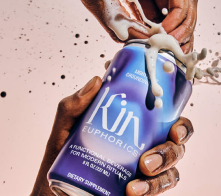In today's digital landscape, our online activities span a multitude of platforms and devices, from web browsing and social media to messaging and smartphones. We're immersed in a world of diverse apps catering to our every need, from e-commerce and work conversations to personal interactions and digital payments. The Internet of Things further adds to this data explosion. With nearly 5 billion internet users worldwide generating an astonishing 2.5 quintillion bytes of data daily, the landscape was already rapidly evolving before 2020. However, the COVID-19 pandemic accelerated this transformation, forcing even the most traditional users to embrace the online world out of necessity.
So, what does this data surge and digital transition mean for brands? Quite simply, everything! The concepts of hyper-personalization and omni-channel experiences in marketing have been gaining momentum for some time. Yet, today's consumers, increasingly conscious of privacy due to high-profile data breaches, demand seamless user experiences. This presents an opportunity for marketers to reassess their approach to personalization, and this is where identity resolution comes into play.
But what exactly is identity resolution?
Identity resolution is, essentially, the art and science of securely identifying an individual customer across various data sources, channels, and devices. It relies on a deterministic or probabilistic identifier to consolidate a person's data, attributes, and interactions from disparate sources. Without identity resolution, customer data remains trapped in isolated silos, rendering it ineffective in the new digital landscape. Implementing a comprehensive customer data strategy entails developing an identity resolution component that can merge these silos into a cohesive, accurate dataset.
Key applications of identity resolution include:
- Personalization & Targeting: Precisely target the right customers across various channels and devices, optimize advertising budgets through frequency capping, and tailor content and ads for a superior customer experience.
- Omni-channel Measurements: Accurately measure interactions across multiple channels and gauge the return on investment and effectiveness of marketing efforts.
- Holistic Customer Insights: Gain a deep understanding of customer behaviors throughout the buying journey, leveraging these insights for data-driven decision-making.
Beyond these core functions, identity resolution also facilitates identifying households, their needs, and personas, in addition to individual consumers. Building lookalike audience segments opens the door to scaling marketing investments and unlocks numerous other data-driven use cases for enterprises.
The strategic importance of identity resolution lies in providing marketers and brands with anonymized master profiles of each consumer, enabling them to engage customers in meaningful moments. This, in turn, allows brands to deliver truly empathetic and memorable customer experiences that not only drive purchases but also foster long-term loyalty.
So, how does identity resolution work in practice?
At the heart of identity resolution solutions are dynamic identity graphs—a continually evolving database of customer identities and touchpoints. This database acts as a single source of truth, connecting customer data from various sources for targeting, measurement, and insights.
A robust identity graph database ensures accuracy, reach, and privacy while effectively utilizing deterministic online and offline datasets to unify customer profiles and fill in gaps when new connections are established. With a future devoid of cookies on the horizon, marketers must adopt an identity-first approach to their customer data strategy. Without identity resolution, it becomes impossible to connect the dots across the customer journey, measure engagement, and deliver personalized, empathetic customer experiences.
Are you prepared to deliver personalized experiences?
At Retention.com, our identity graph has been integral to our technology from the outset. By incorporating customer intelligence into the marketing and measurement equation, we're empowering DTC marketers across the U.S. to personalize the experience and retain customers to achieve robust returns.
Customer retention is vital for brands looking to grow their e-commerce business and cultivate loyal followers. On both Amazon and your own website, implementing strategies to boost repeat purchases from existing customers can significantly impact your bottom line.
From personalized promotions to optimizing your product catalog, here are 7 proven strategies to improve customer retention on Amazon and your website:
1. Personalized Promotions:
On Amazon, tailor promotions for recent, high-spending, and repeat customers. On your website, extend loyalty discounts to your valued customers, ensuring consistency across platforms.
2. Smart Subscription Strategy:
Offer "subscribe & save" coupons to entice customers into regular purchasing habits. The initial discount pays off through increased customer spending over time. This can work on Amazon and your website.
3. Strategic Retargeting:
Utilize a Demand-Side Platform (DSP) for retargeting campaigns, especially for dormant customers. On Amazon, the levers on DSP allow for this granularity while also allowing for the exclusion of subscribe & save customers.
4.Product Journey Insight:
Some products lead customers to buy more products from your brand, others not so much. Identify gateway products that drive repeat sales by analyzing the LTV data of your catalog as a whole. From there, direct your marketing dollars to the SKUs that give you the most bang for the buck.
5. Boost Engagement with Social Posts:
Leverage Amazon and social media posts to build brand followership. Heightened touch-points amplify customer engagement and strengthen brand loyalty. Amazon Posts is free-to-use, and its "Follow" feature builds a connection, ensuring more frequent interactions for sustained retention.
6. Dual Approach Re-engagement:
Combine customer engagement emails (Amazon) and past purchase history (website) for a potent re-engagement strategy. Hit them with the one-two punch, DSP retargeting & email combo for a sure way to drive that re-engagement.
7. Ensure Product Excellence:
Make sure the products you are selling are top quality. High-quality products meet and exceed customer expectations, fostering trust and loyalty, which are essential for long-term retention. When customers consistently receive value, they are more likely to remain loyal, make repeat purchases, and advocate for the brand, solidifying the link between product quality and sustained customer relationships.
By focusing on winning back loyal customers and incentivizing repeated purchases across platforms, you can maximize customer lifetime value while minimizing acquisition costs.
Consult with an agency like Envision Horizons to develop data-driven retention strategies tailored to your brand and products. As a leader in optimizing Amazon and e-commerce success, they're dedicated to elevating your brand's retention efforts. Request a free Amazon growth plan from experts at www.envisionhorizons.com.
With Black Friday and Cyber Monday fast approaching, many businesses are scrambling to put together their email marketing campaigns before time runs out.
If you’ve found yourself struggling for inspiration, you’re not alone. To help speed up the process, we’ve put together some examples that brands have used successfully in previous years, to help inspire your own Black Friday campaign this year.
1. Build Brand Awareness with Social Media Campaigns
QualityWaterLab (QWL) offers buyer’s guides and product reviews designed to educate people about water filtration products.
They decided to build brand awareness by incentivizing their audience to like their social media posts on Facebook. They gave 10% off if the post reached 250 likes, 25% off if the post reached 500 likes, and 50% off if the post reached 1,000 likes.
If you’re using social media to build brand awareness, it’s important to understand your audience. Their demographics can tell you a lot about which social media platforms they’re likely to be using, and you should plan your strategy accordingly.
2. Launch Email Marketing Campaigns Early
Soxy is an online fashion retailer that helps customers find products from brands and compare prices to make sure they’re getting the best deal.
They decided to make the most out of Black Friday sales by encouraging their audience to buy their products as part of their Black Friday campaign as early as October, and to pre-order certain products to make sure they didn’t miss out.
Their sales increased by approximately 20% as a result.
3. Differentiate with Quirky and Creative Email Marketing Copy
DUDE Products is a men’s personal care product brand with a fun, light-hearted style.
To stand out from other brands, they decided to rename their “Black Friday” campaign into “Brown Friday.” While they also included some product discounts, it was the name of their campaign that caught people’s attention and got them to spread the word.
This is a great example of how to capitalize on your brand’s quirks and stand out from the crowd by coming up with something creative that your audience will remember.
4. Host Live Streaming Events with Limited Time Deals
MeUndies is an underwear and loungewear subscription service.
To spread the word about its Black Friday campaign, it held a “Black Friday drawer buster event” — a two-hour party hosted on Facebook Live, featuring a DJ and dancing contests. Overall, the event attracted over 13,000 people.
As the event progressed, attendees unlocked access to increasingly bigger discounts. Attendees converted at 25% — 13 times higher than the brand’s average conversion rate.
Live selling can feel daunting — especially if you’ve never done it before. Many brands are scared that it won’t go perfectly, which means they don’t even try. This is exactly why it’s a perfect way to stand out and gain an edge over your competition.
5. Segment Your Email Marketing Lists
Matero sells caffeinated herbal tea that is popular in South America.
During the brand’s Black Friday campaign, it sends out at least one email per day to let customers know what is on sale that day, and how much time they have to purchase before the sale is over.
The secret to making these emails a success is segmenting the email lists and making them more personal. For example, a brand-new customer who has never tried the tea will receive a very different email than a loyal customer who has been ordering from the brand for years. The brand reported that doing this doubled its conversion rate.
While writing out multiple emails is significantly more time-consuming than sending out the same email to all of your customers, your Black Friday campaign is the chance to put in the effort.
It is the single biggest shopping event of the year, after all.
6. Boost sales and increase customer engagement this year with your Black Friday campaign
Using social media campaigns to build brand awareness, launching campaigns early, using creative copy, planning your own live streaming events to promote deals, and segmenting your email marketing lists can help you to feel prepared when Black Friday rolls around on November 24.
Not sure where to start with your holiday planning strategy? Download our Black Friday/Cyber Monday marketing playbook to make sure you capture every sale and every dollar this year!
Nothing stirs fear in the hearts of eCommerce marketing teams quite like a new Apple privacy announcement. And their most recent edicts concerning link-tracking changes in iOS17 are no exception.
The privacy landscape is constantly changing, and we’re all evolving in stride. Let’s walk through some of these changes, whether or not they’ll affect you, and what Retention.com is doing to stay ahead of them.
What’s Changing?
According to Apple’s recent announcement, Link Tracking Protection is likely to be enabled by default in Apple’s Mail app, Messages, and Safari's Private Browsing mode.
As with most new iOS changes, we expect that this will roll out in September or early October when the new iOS is usually released to general consumers. Fortunately, it often takes a couple of months for wide adoption of the new iOS.
What will Link Tracking Protection Do?
Link Tracking Protection aims to strip certain query parameters from URLs in Apple Mail, Safari Private Browsing Mode, and Messages.
What are query parameters? They can include:
- Social: ?utm_source=facebook&utm_medium=social
- Facebook: ?fbclid=99999
- Google Ads: ?gclid=8888aaaa
- Impact Radius: ?irclickid=999aaa
- Klaviyo ?kx=7777
- And more…
First things first, this will not impact your regular social utm codes (utm_source, utm_medium, etc). Nor will it strip Impact Radius or Klaviyo query params, or even custom utm parameters.
This is good news.
What’s The Worst Case Scenario?
So, what will be affected?: The parameters added by Google and Facebook: fbclid and gclid.
This will hurt Google Analytics’ ability to track your Google Ads, Meta’s ability to track Facebook Ads, and Facebook’s Conversion API.
Yikes? Actually, not so scary. Remember, Link Tracking Protection is only happening in Apple Mail, Messages, and Safari Private Browsing mode. Most shoppers do not use Safari Private Browsing mode, the only place where Google Search Ads should be affected. And most Facebook shoppers shop directly through the Facebook Native App.
In short, we expect that this won’t really affect most of your tracking.
Then comes Apple Mail, which has around a 50% market penetration rate. This is where you’re likely to lose Google and Facebook attribution parameters (gclid and fbclid). Your other parameters should still work.
Let’s talk about what this really means. Losing fbclid and gclid parameters in emails received through Apple Mail (or through Messages/Safari Private Browsing) can cause some headaches for you, such as:
- Broken attribution
- Broken conversion tracking
- Reduced marketing and targeting efficiency
- Trouble setting cookies for event/conversion hits
Wait, broken things?
Well, as mentioned above, this really only impacts gclid and fbclid attribution via Google Analytics, Facebook Conversion API, and Meta ad tracking, and only in this one channel. All your other attribution methods should still be fine.
Here’s a reminder of what’s not going away (at least not yet, as far as we can tell):
- Klaviyo, TikTok click iD parameters
- Link tracking in browsers like Chrome or Firefox
- Link tracking in regular Safari browsing mode
- The standard 5 UTM parameters (utm_source, umt_medium)
- Custom UTM parameters (utm_term, utm_content, etc)
The result? This really won’t affect that much of your attribution.
What Should eCommerce Brands Do About This?
Since we have time to adapt before the changes really take hold, let’s be pragmatic about it:
First, consider your channels - Remember that only some link tracking parameters will be affected in only some channels, and most people won’t be shopping through those channels.
Second, consider your attribution tracking - Are you wholly reliant on Google Analytics/Facebook to track your performance, and are you only using Google Ads? There’s no time like the present to consider alternative options.
Third, lean in to attribution methods that are not being affected. Make sure you’re exercising everything at your disposal to track the customer journey and maintain that valuable attribution.
Will This Affect Retention.com’s Product?
Nope.
This change shouldn’t have a noticeable impact on our current product suite. Social advertising attribution tracking from an email click is a small pool to begin with – and when the specificity of in-private browsing is added, the pool gets even smaller.
Retention.com will still serve you up with plenty of net-new, high-intent customers that you otherwise would be losing, and you’ll still be able to market to them using your existing marketing automation tools with all of your regular attribution methods. No changes there.
While these announcements can seem scary, rest assured that our team of seasoned eCommerce and agency experts is staying way out ahead of the curve.
Want to talk more?
In the dynamic world of digital marketing, effective audience retargeting is a crucial strategy for businesses aiming to maximize their online advertising efforts. Retargeting allows brands to reconnect with users who have shown interest in their products or services, providing a higher probability of conversions. To accomplish this, leveraging both third-party and first-party data is essential. In this blog post, we will delve into the importance of combining these two data sources and explore how their synergy can amplify retargeting efforts, drive engagement, and boost overall marketing success.
Understanding Third-Party and First-Party Data:
Before delving into the benefits of combining third-party and first-party data, it's essential to grasp their distinct characteristics.
Third-party data refers to information collected by external entities unrelated to your brand. These sources can include data aggregators, publishers, and other companies that track user behavior across various platforms. Third-party data offers broad insights into consumer preferences, interests, and demographics, making it a valuable resource for targeting specific audience segments.
On the other hand, first-party data is generated directly from interactions between your brand and your customers. This data is typically collected through website analytics, customer relationship management (CRM) systems, email marketing platforms, and other owned channels. First-party data provides a deeper understanding of individual user behavior, preferences, and purchase history, allowing for highly personalized retargeting campaigns.
The Synergy of Third-Party and First-Party Data:
1. Comprehensive Audience Insights
By combining third-party and first-party data, businesses can access a holistic view of their target audience. Third-party data adds depth to the understanding of customer segments by providing broader demographic and interest-based insights. Meanwhile, first-party data offers granular details about individual user behaviours, enabling brands to create highly personalized retargeting campaigns.
2. Enhanced Audience Targeting:
Integrating third-party and first-party data enables brands to refine their audience targeting strategies. Third-party data allows businesses to discover new potential customers and expand their reach, while first-party data enables precise targeting of existing customers and prospects who have already shown interest. By combining these two data sources, brands can create highly relevant and targeted ad campaigns that resonate with their audiences, increasing the chances of conversion.
3. Improved Campaign Performance:
The synergy between third-party and first-party data can significantly enhance campaign performance. Third-party data provides valuable insights that help identify high-value customer segments, while first-party data enables personalized messaging and tailored offers. By leveraging both data sources, businesses can optimize ad delivery, create compelling content, and improve campaign efficiency, resulting in higher engagement and conversion rates.
4. Customized Customer Journeys:
When third-party and first-party data are used in tandem, brands gain the ability to create customized customer journeys. By understanding customer preferences, interests, and behaviors from first-party data, businesses can identify touch-points where retargeting efforts can be most effective. Third-party data then enhances this personalization by providing additional context and insights into customer behavior outside of the brand's owned channels, enabling the delivery of relevant messages at the right time and on the right platform.
Conclusion
In the realm of audience retargeting, the combination of third-party and first-party data is a winning formula for success. By leveraging both data sources, businesses can create powerful, personalized campaigns that resonate with their target audience, enhance engagement, and drive conversions. The comprehensive insights obtained through third-party data, when combined with the granular details of first-party data, enable brands to optimize their retargeting efforts, deliver highly relevant messages, and build long-term customer relationships. In the ever-evolving landscape of digital marketing, harnessing the power of both third-party and first-party data.
Dr. Squatch captures elusive cart abandoners for legendary BFCM success
Dr. Squatch is the largest men's natural personal care brand in the United States. Its mission? To raise the bar for the men's grooming industry and change the way men approach their hygiene by providing healthy, natural products that allow you to feel like a man and smell like a champion.
Book A Demo

Industry
Ecommerce Marketplace
Objective
Drive Revenue and List Growth
Solutions
Retention.com Reclaim, Browse, & Cart
"For Black Friday/Cyber Monday, we got over a million dollars of revenue just from customers acquired through Retention.com."
– Cody Griffin, VP of Marketing, Dr. Squatch
Performance Results
#1
Generative Email Flow
$1MM
Increase in BFCM Revenue
50x
ROI
Bring on the Challenge
About Dr. Squatch.Dr. Squatch is the largest men's natural personal care brand in the United States. They make soap, deodorant, haircare, lotion, and cologne designed specifically for men with 100% natural products and no harmful ingredients. Dr. Squatch brought Retention.com on at the end of summer in 2022 with one very specific purpose: Grow their email list of bottom-of-funnel, warm leads in advance of the Q4 holidays. But they had doubts. How would using Retention.com's cart abandonment technology affect: 1. Deliverability2. Spam score, and 3. Brand reputation? Any smart marketer should be concerned about all three!
Retention.com to the Rescue
Dr. Squatch worked directly with Retention.com to unlock vast new bottom-of-funnel emails.
To gauge performance, Dr. Squatch started by turning Retention.com on for a small section of the website where the traffic was really low. They had Klaviyo perform deliverability and spam audits.
The results?
- No problems with deliverability
- No problems with spam
- High conversions
But what about the brand reputation?
"We put on our customer hat and realized that all of us receive emails every day that we don’t necessarily know where we signed up to get those emails," said Cody Griffin, VP of Marketing, Dr. Squatch. "But ultimately when they are relevant to our experience we find them valuable. So all of those were very fine with us.”
This paved the way for Dr. Squatch to turn Retention.com on for the whole site. They are now capturing a new first-party data set of highly-engaged prospects from these formerly anonymous, abandoned sessions, so they can continue to keep the core of their community connected to all their new offerings.
The Results
Retention.com was Dr. Squatch's number one generative email flow, adding over $1MM in BFCM revenue for 50x ROI. "We really wanted to deliver a successful Black Friday/Cyber Monday period and we knew that having a larger list size in advance of that would be an advantage to converting those potentially warm customers at a very high-value moment for them.” “Within less than three months we saw a huge transformative outcome... it was our number one generative flow in our email system. "For Black Friday/Cyber Monday we got over a million dollars of revenue just from customers acquired through Retention.com." We got an ROI on our investment that was greater than 50x what we paid for those emails from Retention.com, which meant pure value for us.”
– Cody Griffin,
VP of Marketing, Dr. Squatch
Inspire Uplift Goes All In on Direct to Customer Marketing
Inspire Uplift connects millions of online buyers and sellers worldwide.
Book A Demo

Industry
Ecommerce Marketplace
Objective
Drive Revenue and List Growth
Solutions
Retention.com Reclaim, Browse, & Cart
"Retention.com’s platform has been extremely user-friendly and their support has helped us with strategy that has allowed us to see amazing results quickly. We were up and running a week from onboarding, and collecting thousands of emails each day."
– Aaron Wallace, Founder, Inspire Uplift
Performance Results
56%
Engagement Rate
+10%
Increase in Revenue
8.8x
ROI
Bring on the Challenge
About Inspire Uplift.Already an established global marketplace, Inspire Uplift proudly serves over two million satisfied customers, worldwide, and has over ten million fans and followers on social media. That’s why our platform is the perfect place to connect with millions of potential buyers who are looking for that perfectly unique item, whether handcrafted, vintage or otherwise. At a time when trust and reliability are in short supply, we pride ourselves on our secure, honest and dependable service! That’s why we’ve been busy preparing a place where our community of online sellers can feel comfortable and confident as they express their creativity and turn the ideas that they’re passionate about into successful enterprises! Inspire Uplift had two priorities when partnering with Retention.com:
- Drive email subscriber growth
- Generate more revenue
Retention.com to the Rescue
Inspire Uplift partnered agency with BMO Media to leverage Retention.com's Reclaim, Browse, and Cart Abandonment Solutions
BMO Media helped Inspire Uplift create a new messaging strategy for their welcome, browse and cart abandonment email flows to trigger one-to-one messaging to high intent prospects. Each flow targeted a net-new audience, and personalized discounts to lead to sky-rocketing conversion and overall engagement rate.
Inspire Uplift is also capturing a new first-party data set of highly-engaged prospects from these formerly anonymous, abandoned sessions, so they can continue to keep the core of their community connected to all their new offerings.
The Results
10% increase in top-line revenue with a 56% open rate for these new targeted emails. InspireUplift grew their entire mailable list by 25% within 2.5 months of using Retention.com! Just like that, InspireUplift has converted abandonment into thousands of new customers, many completing multiple transactions.
"I can’t wait to see the future of the platform as new functionality within the platform is consistently being developed.
Retention.com will not only help with “retention” but I foresee it helping so much on the acquisition side."
– Aaron Wallace,
Founder, Inspire Uplift
When it comes to running an online business, data is one of the biggest focuses. How you collect it, how you use it, and how much you spend on data can make or break your business. With first-party data, you have an opportunity to maximize your retention marketing. You’ll learn your users better, lower your data collection costs, and gain more flexibility.
In this guide, you’ll learn everything you need to know about first-party data. You’ll learn what it is, how it works, why you should use it, and how to implement it.

What Is First-Party Data?
First-party data is any data that you can collect directly from users. This data could be collected while they browse your site, interact with your social media accounts, use your app, or fill out a survey from you.
There are also second-party and third-party data, and both of those include another degree of separation. First-party data is the only case where you get the information directly from the user through your own channel.
Second and third-party data entail paying another company for the data. In this case, the company you’re buying it from either gathered it as first-party data or paid another company that did.

Benefits of First-Party Data
There are a lot of reasons to opt for first-party data. Whether you run an online business or an eCommerce company, this type of data can help a lot.
Control How, What, and Where You Get the Data
The biggest benefit of first-party data is all the control you get. Since you’re setting up how the data is captured and ultimately using the data on your own, you’ll get more flexibility.
You can choose to collect very specific pieces of data from users when they access your site in a specific way. This can be molded to perfectly match the requirements of your company.
What you later do with the data is entirely up to you. Since this is a lower-cost option of getting data, there’s less pressure to use the data.
Segment Your Data
Another benefit of collecting your own data is your ability to segment it. Segmenting is the act of breaking data down into types, then categorizing and lumping data together.
With segmented data, you get a better picture of what’s going on. In addition, you get a more complete image of who your user is.
If you understand your user better, you can optimize your retention marketing campaign. Use the data to focus on what appeals to the user. Target them at specific times, and use specific websites that align with the profile you built based on your first-party data.
Lower-Cost Option
Every time you add another party, the price goes up. Buying third-party data is significantly more expensive than first-party data.
With first-party data, you’re getting the lowest cost option.
Understand Your Shoppers Better
The bottom line is that first-party data helps you to understand your shoppers better. In the online marketplace, data is the key to unlocking bigger profits and more sales.
It’s easier to sell something if you know the potential buyer very well. If they’re a stranger, it’s harder to convert them.
Data allows you to become familiar with your shoppers.

How to Use First-Party Data
Knowing the benefits of first-party data is just the first step. Next, you’ll need to know how to use the data to your advantage.
Optimize Your Targeting Campaign
One of the most effective ways to use first-party data is through specific targeting campaigns. In these campaigns, you’re reaching out to very specific people that meet your demographic and target audience.
If you sell cat food, it helps to target people who own cats. With first-party data, you’ll be able to find users who own cats, find out other interests about them, and combine them into a more successful targeting campaign.
This is just one example of how targeting works better when you have first-party data in your corner.
Customize Your Automatic Emails
Automatic emails and marketing campaigns offer the benefits of marketing without the need to spend time and resources putting it together.
With these emails specifically, it’s easy to make a mistake and create emails that are too vague and not personal enough. With first-party data, you can create customized messages for all of your recipients.
Again, you’ll be using the information you learned about the user when they browsed your store. Appeal to their interests in an effort to convert them.
Re-Engage Your Audience
The same is true for an audience that you need to re-engage. After some time after buying from you, you should send another message and entice them to shop with your store again.
With first-party data, you can build up a more complete list of users. This goes beyond just their name and payment information — you can compile data that allows you to specifically re-engage with each user.
When an email feels personalized and targeted, the user is more likely to follow up and engage with your company again.
Boost Your Brand’s Trustworthiness
At Retention.com, the philosophy is to use retention marketing in junction with your brand’s strengths. For many, trustworthiness is one of the leading focuses of an online business.
After all, there are so many suspicious sites online. To be trustworthy means that people can shop with you without fear and that typically translates to more money.
First-party data always starts with an interaction between the user and your site. They will specify which data they want to share.
Doing this shows that you care about your user’s comfort. If they don’t want you to access their cookies, then they can un-check the box and trust you more.
Conclusion
Understanding first-party data is a great way to start making more money and converting more users. This form of data is captured directly from the user as they access your site. It’s low-cost, flexible, and very valuable for your retention marketing.
If you need a high-quality retention marketing solutions provider that helps you use first-party data to grow your business, you can turn to Retention.com. Our team will help you understand and implement data that can boost your sales.
You know when someone tells you you’re amazing and that anyone would be lucky to have you, and then you never hear from them again? That’s kind of what cart abandonment feels like. To take away some of that sting, you can send them emails to hopefully bring them back. And to do that, you’ll need the help of some engaging abandoned cart templates.
Before we get to those, let’s cover some of the basics when it comes to these email campaigns — like why they are so important to your retention marketing strategy.
With cart abandonment rates as high as 80 percent for some companies, that’s a lot of revenue you are missing out on if you aren’t doing something to bring them back. That’s why it’s imperative you set up an automated cart abandonment email series to send those wayward shoppers back to their carts to convert.
But don’t just take our word for it. Check out some of these encouraging abandonment rate statistics that will help you forget that 80-percent one we threw at you already:
- Since 2016, open rates for cart abandonment emails have stayed around 45 percent.
- Cart abandonment email click-throughs are at about 21 percent.
- And 11 percent of abandoned cart emails result in a conversion.
Those stats show you that when you reach out to customers with a targeted message after they take action, you can get results. You’re able to recognize when a customer is interested in a product (they did just add it to their cart, didn’t they?), and you can then reach out to them and send them to their cart.
Win them back
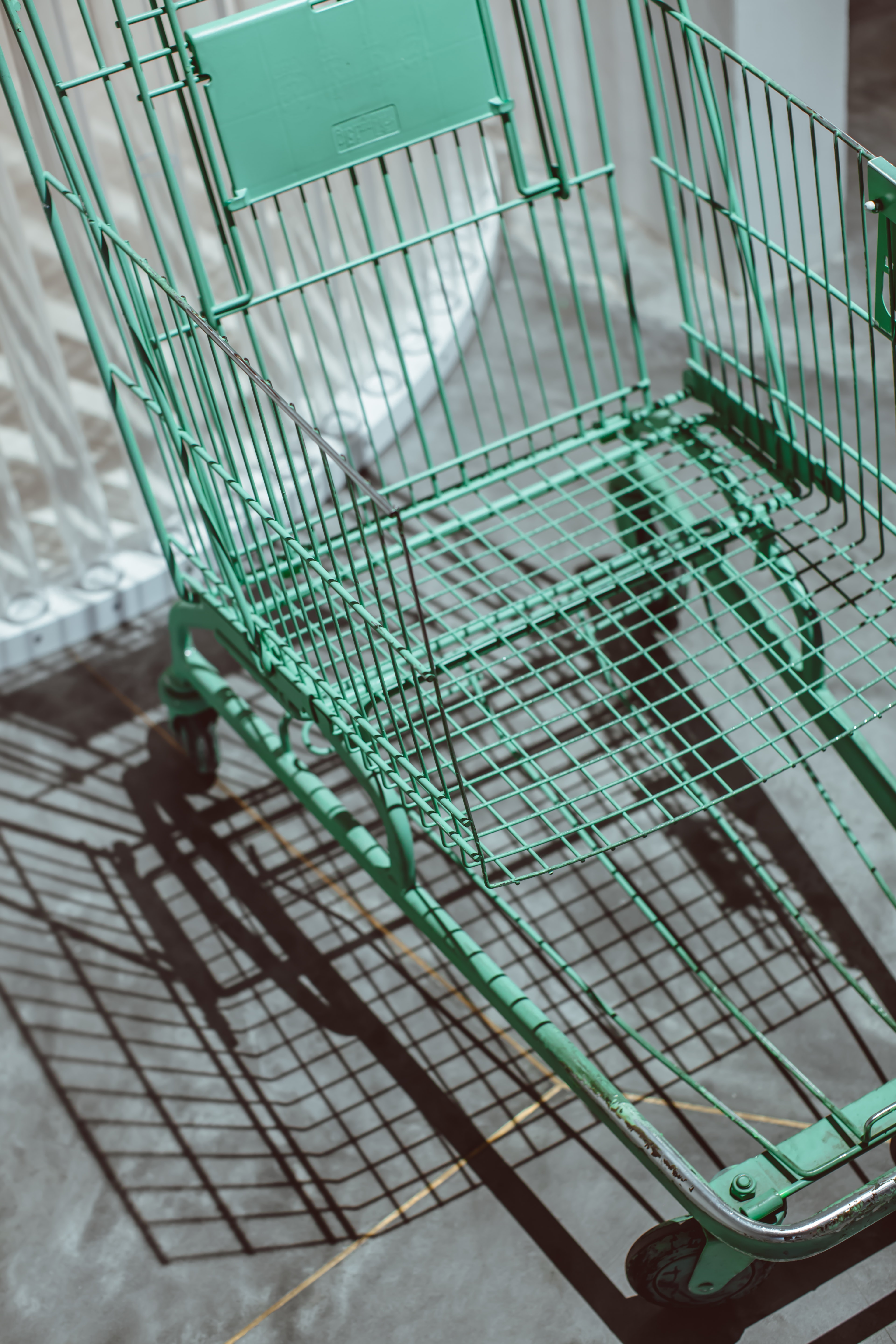
Ready to start experiencing some of those numbers for your brand? We’ll walk you through ways to do that in this guide, covering topics including:
- What is cart abandonment?
- What are abandoned cart emails?
- Platforms you can use to send these emails
- Cart abandonment email strategies
- Examples of abandoned cart templates and emails
- Is it legal to send abandoned cart emails?
We’ll share tips, techniques, abandoned cart templates, and more that will help you improve the effectiveness of your abandoned cart emails.
What is cart abandonment?
The shopper has browsed your site, added one or more items to their cart, and left for some unknown reason, never completing their purchase. For example, we’ve added this item to our cart on Amazon. But instead of clicking the button to checkout and providing our billing and shipping details, we left the website altogether.

The idea of “cart abandonment” is the equivalent of someone walking into a brick-and-mortar store, putting items in their cart, and then leaving before heading to the checkout counter.
It’s pretty straightforward, but that doesn’t make it hurt any less. Luckily, there are things you can do to bring them back, and one of the best methods is via email.
What are abandoned cart emails?
This type of email marketing campaign helps you recapture lost sales by engaging shoppers who abandoned their carts. Basically, the email reminds them to complete their transaction — of course in a nice, fun way.
If you’ve ever added a product to your cart and then ditched it, you’ve seen exactly what we’re talking about. They have subject lines like, “Did you forget something?” or “Your cart misses you.”
Inside the email, you’ll most likely find some engaging copy that encourages them to head back to their cart, along with a photo and description of the product(s), and at least one CTA. Some brands also include information on their shipping, returns, and other selling points at the bottom of the email.
How do these emails work?
Abandoned cart emails are examples of automated campaigns. Here’s how they work:
- You have an online site/platform that tracks user actions on your site.
- Your platform records the products they browsed, what they left in their shopping cart, and their purchases.
- With that information, you can then send automated emails to the shoppers after they abandon their cart.
So once the shopper adds an item to their cart and leaves your site, the platform will register this action (or lack of action, really) as an abandoned cart.
E-commerce sites like Shopify and BigCommerce will automatically track the shoppers’ actions and metrics, making your job that much easier. (And Retention.com has integrations with both of those platforms that allow you to track your revenue from contacts we provide.)
Some of these e-commerce platforms have basic abandoned cart emails, but you can also integrate with your email service provider (ESP) to create and house them there. That will give you more options when it comes to abandoned cart templates. You will simply need to integrate your e-commerce shop with your email marketing tool to create fully customizable, multi-step email campaigns that send multiple emails at certain times based on when they abandoned the cart.
Whether you use the basic abandoned cart templates available in the e-commerce platforms or in your ESP, these will automatically be sent out to potential customers who have abandoned their carts.
Abandoned cart email templates via e-commerce platforms

While you will be more limited when it comes to abandoned cart templates on sites like Shopify, BigCommerce, and WooCommerce, you can use these platforms to send your abandoned cart emails. So, we’ll walk you through how you can create emails on these platforms.
Shopify
You’ll find some basic functionality on Shopify when it comes to creating and managing your abandoned cart emails by going to Settings > Checkout (under Abandoned Checkouts). However, if you want to be able to control the abandoned cart templates and content, you’ll have to install an app like Consistent Cart App, Abandoned Cart Recovery, Jilt, or Privy.
WooCommerce
Since WooCommerce doesn’t have built-in functionality for cart abandonment emails, you could use either the platform’s official extension, Follow-Ups, or a free plugin like Abandoned Cart Lite for WooCommerce.
If you go with the plugin option, you’ll see a new section in your WooCommerce dashboard: Abandoned Carts. That section will be where you can check recovered carts, edit your email content, change the sending settings, and other features.
BigCommerce
Of these three e-commerce platforms, BigCommerce is the only one that gives you full control over your abandoned cart emails. You’re able to control the email design — like what products, text, and images they include — as well as how many emails and when you send them. You’ll find the settings in Marketing > Abandoned Cart Notifications.
Third-party email marketing tools
If you want to go beyond basic abandoned cart templates and settings, it’s time to turn to a third-party ESP. That will give you full control over the look, text, and automation functions.
You can integrate your ESP with your e-commerce platform making it a seamless transition: They leave something in their cart, and the ESP triggers an automated email campaign series that will (hopefully) bring them back to their cart. There are dozens of ESPs to choose from, so find one that best fits your needs.
Cart abandonment email marketing strategies
Now that you have a way to send shoppers an abandoned email, you need to know what tactics that email should include to increase your chances of bringing them back. Here are six ways to boost your recovery rate.
- Build trust and credibility.
- Put your loyalty program to use.
- Focus on one product (sometimes).
- Implement an automation series.
- Create a sense of urgency.
- Address issues that might have kept them from purchasing.
Now, let’s dive into each of these techniques a bit more to see how you can implement them into your cart abandonment email strategy.
1. Build trust and credibility
In this day and age, it’s harder to earn online consumers’ trust because they’ve become accustomed to scams and unprofessional business practices on the Internet. If they’ve never done business with your brand before, you have to work even harder to earn their trust if you expect them to return to their cart and make a purchase. They aren’t going to turn over their credit card information to just anyone.
You can do that by showing them customer reviews and ratings for the product(s) they left in their cart. Make sure your site and emails look professional and include the basics: physical address, reply to email address, logo, and any payment verification information (showing it’s safe for them to use their credit card on your site).
2. Put your loyalty program to use.
Everyone loves a good discount. That’s why you see so many abandoned cart emails that offer shoppers a deal if they come back to their cart. For example, “We have great news! That [PRODUCT] you liked is now 20 percent off!”
But as consumers become accustomed to this tactic, it can lose its effect. So, instead of offering them a deal, try a different approach by giving them rewards in your loyalty program. Again, this is something you can try out to see if it works better than your regular discount message.
You could give them enough rewards points to move up to the first/next tier in your loyalty program — which then gives them a discount. Maybe 100 points is enough for a 10-percent discount. Or, 200 points will give them a $10 discount. They are still getting a deal out of returning to their cart and making a purchase, but you go about it in a different way — and they are able to move up in your program in the process.
3. Focus on one product.
It can be tempting to include both the item they left in their cart and also other recommended products in an attempt to up-sell the shopper or catch their attention. While it’s a good practice to try different approaches with your cart abandonment emails, try only focusing on one product when they add multiple, similar items to their cart.
For example, if a shopper has five different computers in their cart, you can bet they don’t plan on purchasing all five of them — or at minimum, they don’t have equal purchasing intent for all of them. So, your abandoned cart template could include one of the items as the main image, along with the product description.
4. Implement an automation series.
Sending one email letting them know they forgot something in their cart is most likely not going to be enough. Just like you would send someone multiple welcome emails, you need to create an automated series to engage shoppers who have left items behind.
Don’t wait too long before sending the first email in the series. The moment an online shopper leaves their cart, your opportunity to engage this potential customer is narrowing. To make the most of this opportunity, make it a priority to reach out to shoppers within the first hour of cart abandonment. Make this part of a three- or four-email sequence to engage with the shopper.
For example, the first email can go out an hour after they abandon their cart. Then, the next one can follow up one or two days later if they don’t complete their purchase, using a different approach with the email’s content and approach.
If both of those email attempts don’t work, you can try a third (or fourth) campaign that focuses more on the product’s category or general new products. They might not have been that interested in what they added to their cart, so taking a more general approach might be a better way to engage them. The third or fourth email attempt is more of a last-ditch attempt to re-engage with a shopper who has been unresponsive to the first ones in the series.
Sending more than three or four runs the risk of annoying the recipient and getting placed in their spam folder. And we all know that’s the last place you want your messages to go.
5. Create a sense of urgency.
There’s nothing like a reminder that a certain deal is about to expire or that the product in their cart is about to sell out to push them to take action. Use that fear of missing out and urgency as a marketing tactic.
Subject lines are a great place to include this method:
- These products won’t last for long
- Going, going, almost gone!
You can also let them know they only have a certain number of days until the items will be removed from their cart. And who really wants to have to go and add them back, right? Find a way to motivate them to head back, sooner rather than later.
6. Address issues that might have kept them from purchasing.
There are a dozen reasons why they may have left their cart behind. Maybe they changed their mind or found something else they liked better. There’s not much you can do about those two things, but there are other potential roadblocks you can remove and/or address to get them back:
- Include your shipping prices and turnaround time in the email.
- Let them know your returns policy.
- Show them your accepted payment methods (and make sure you have several).
The more potential issues you can eliminate and be proactive about, the better your chances are that they will come back.
Examples of abandoned cart templates and emails
One of the best ways to get ideas for your brand’s abandoned cart emails is to see what other brands are doing and what templates are available in different ESPs. So, we’ve put together a list of templates and real email examples to get your creative juices flowing. You can find others in your ESP’s template library, depending on which platform you use.
We’ll also show you what we like about the actual examples and what they could have done better.
Don’t forget me (template)
Robly has several pre-designed abandoned cart templates, in addition to other template options you can design to be for abandoned cart emails. Here’s the first of three template examples we’ll show you:
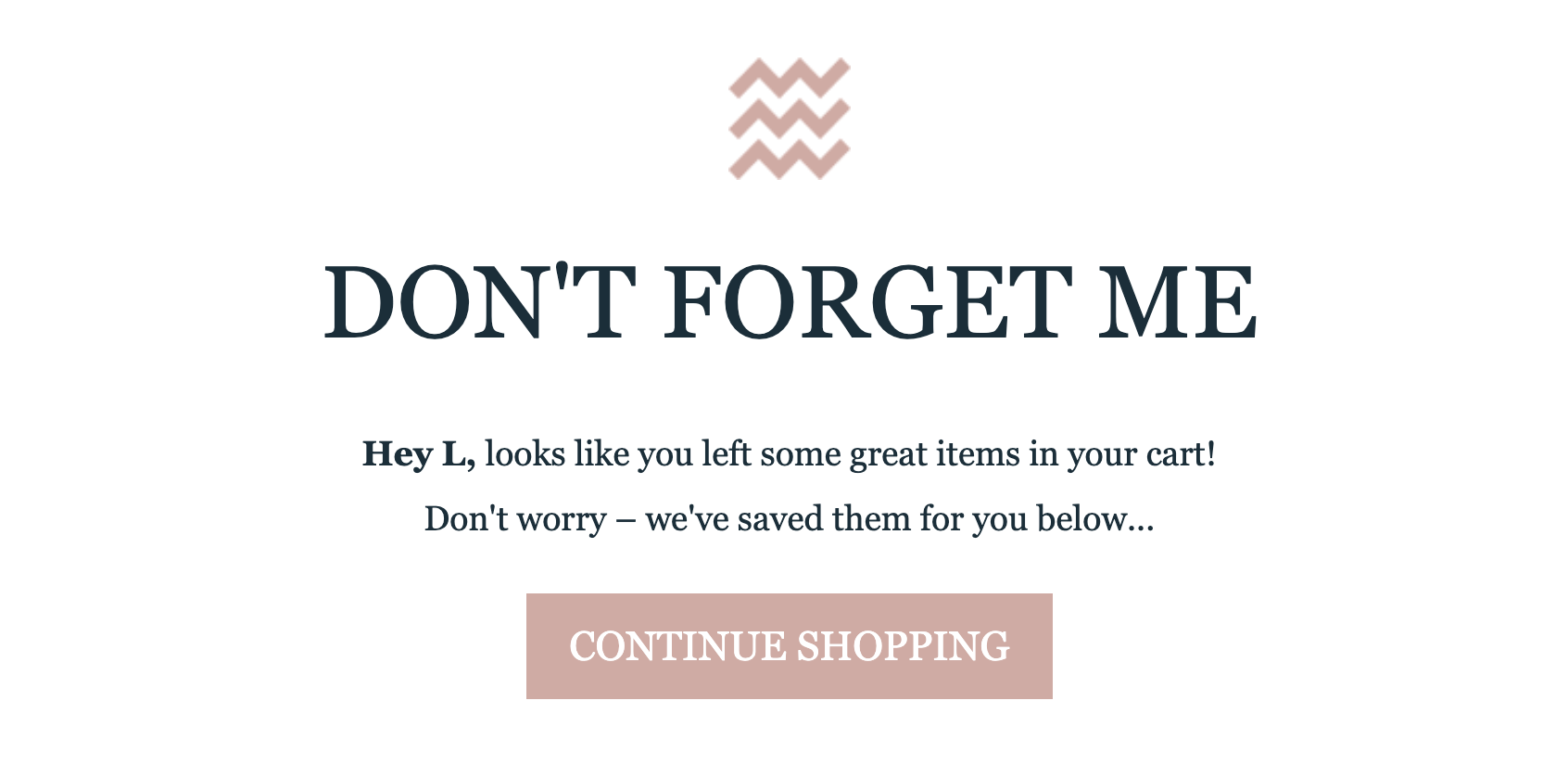
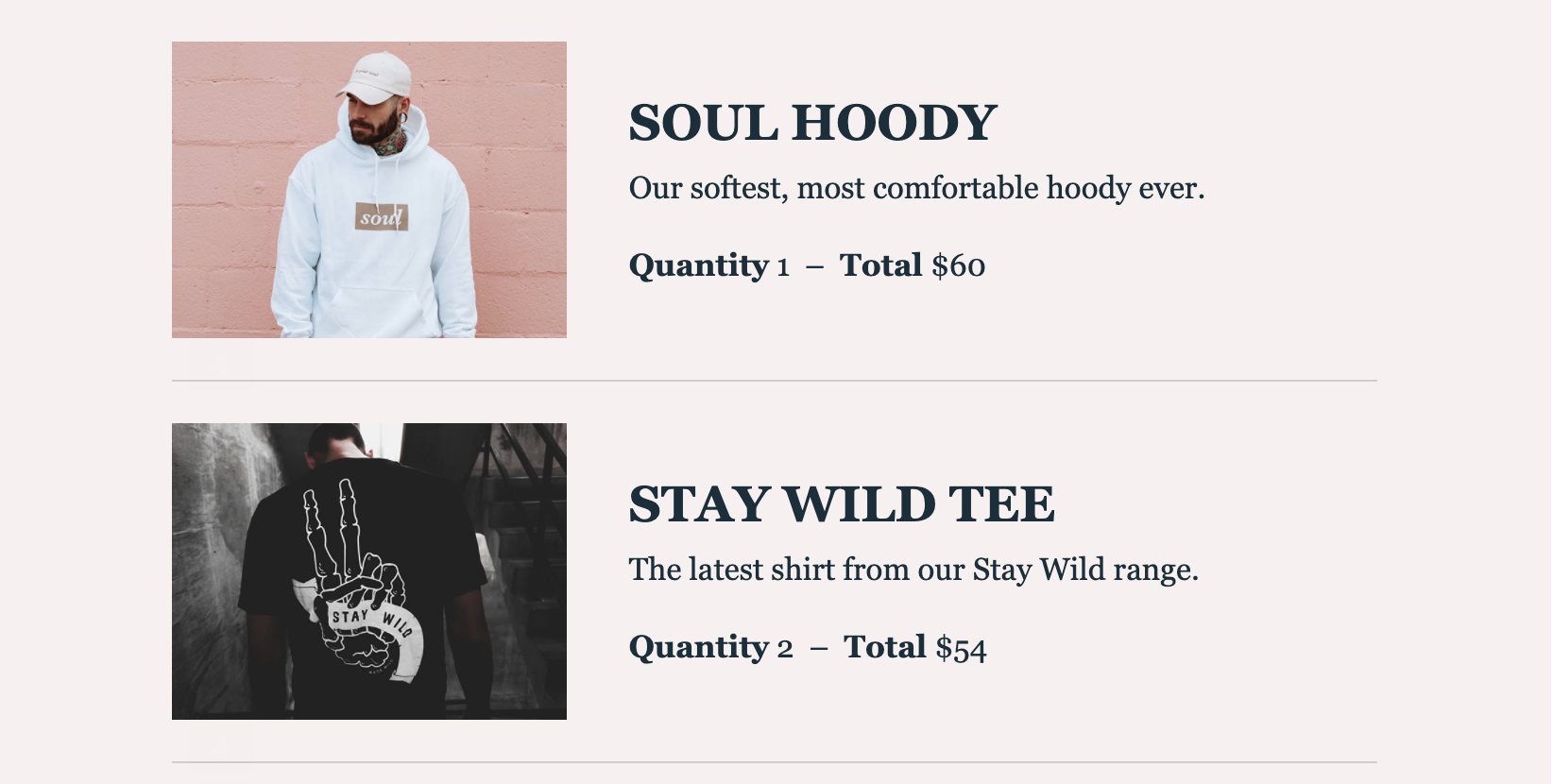


And being a template, you can edit the text, colors, images, links, and everything else to best brand your email.
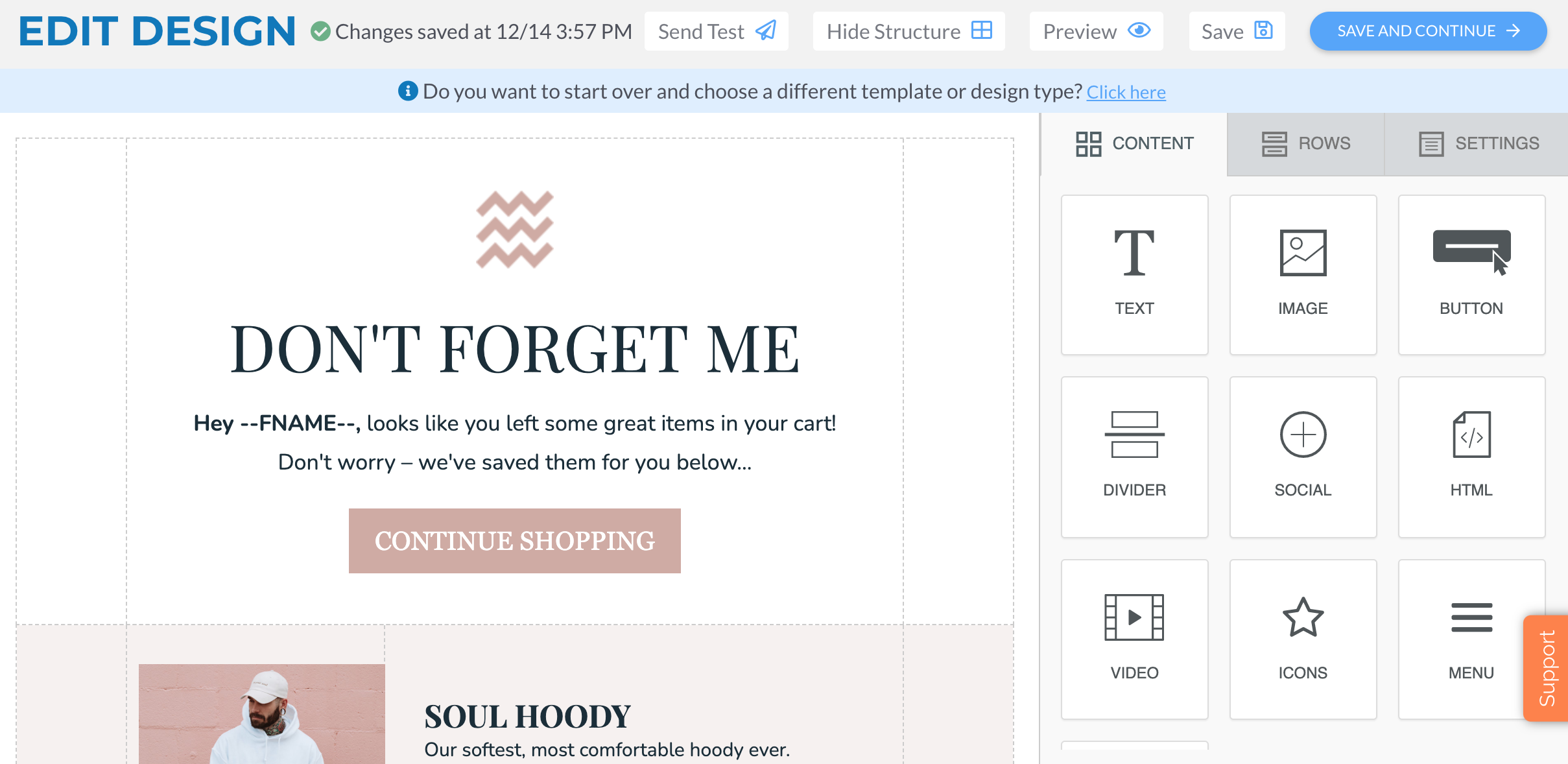
Obviously, you’ll need to change out the photos, product descriptions, branding, etc. with your own materials. But what we like about this template is that it gives you usable text — like “Don’t Forget Me” and “Hey [FNAME], looks like you left some great items in your cart! Don’t worry, we’ve saved them for you below.” The CTAs even fit the content, so you can use what’s already there.
Topo Designs (email)
Subject line: Go ahead, take another look
This email from Topo Designs doesn’t scream “abandoned cart,” but that helps make it different and less forceful. (Though the subject line does allude to it.) When you first look at it, the email seems to be about offering customers a deal on items the brand thinks they will enjoy. But when you scroll down, you see that there’s an item that was left in the cart.
The approach in this abandoned cart template would be especially effective if it was used in the second or third email in the series.
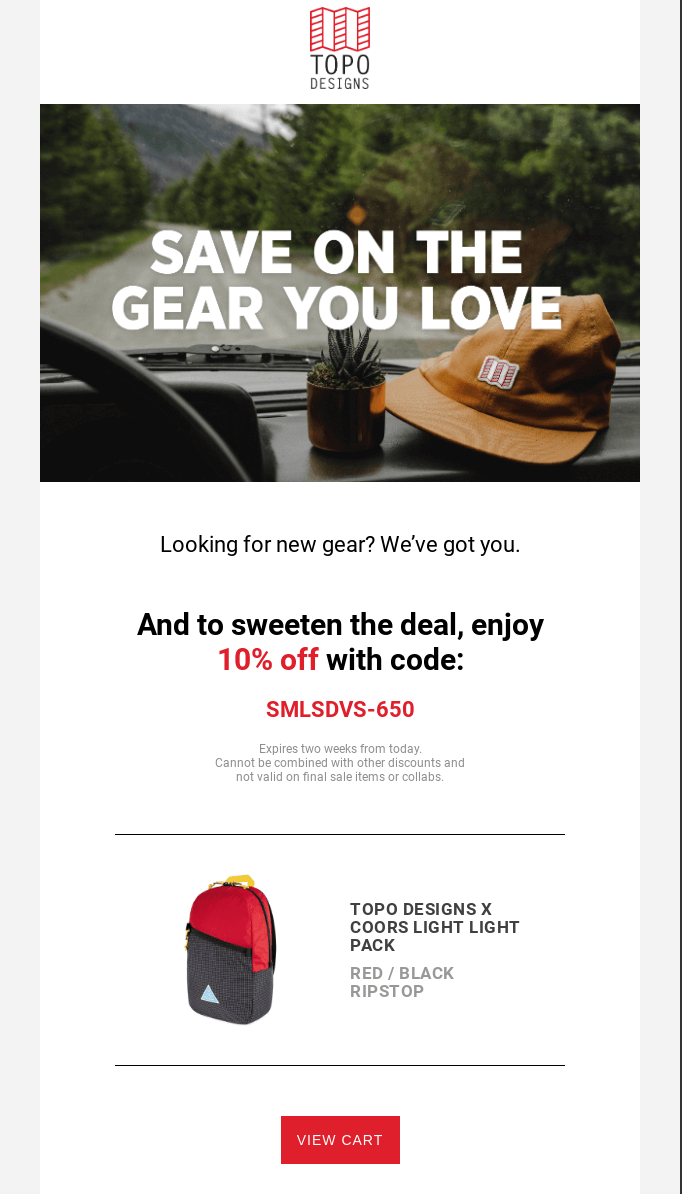
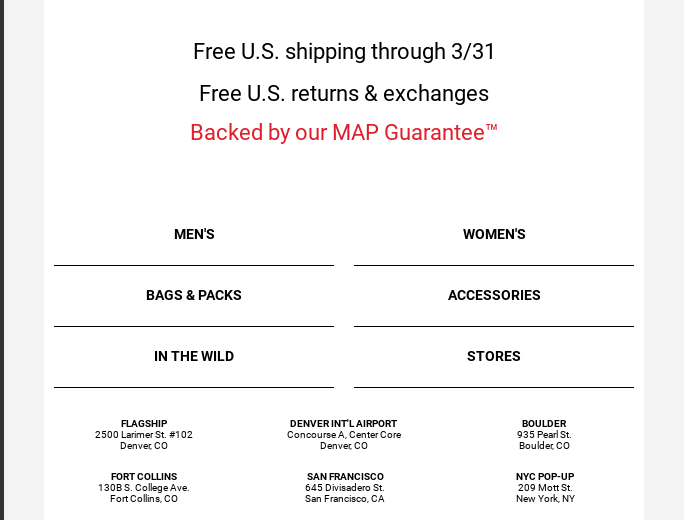
What else we like:
- They show a product photo, description, and clear CTA that just so happens to match the product colors.
- Knowing shipping and returns can be a hurdle for many online shoppers, the brand addresses that by letting the shopper know both of those are free.
- They close out the email by including links to their different departments, in case the shopper would be more interested in one of those. That gives them choices without throwing a dozen different products into the email, which can be overwhelming.
- There’s also a list of their locations with addresses, which adds credibility to the brand.
What could have been better:
- They don’t include the product’s price, and we feel like the shopper will want to know that before heading back to their cart. Since this email offers a discount, the price could even be marked out and show the new price with the 10-percent discount applied.
Still not sure? (template)
Another Robly option, this abandoned cart template shows how the email design can be as targeted and personalized as the text. The header image is a pair of headphones, the same thing they added to their cart.
Sure, you might not be able to have an image like that to match each product, but you could probably create one for your main categories — like a shirt for the clothing department, a computer for electronics, or flowers for the gardening/outdoors category. Anything you can do to personalize the email, the better.
This template also comes with filler text that you could use as is (after changing out the products and images, of course): “We noticed you found these [PRODUCTS] but haven’t checked out yet — here’s some more details to help you decide!”
The template then includes the product photo, price, a product review, and star rating. And of course, there’s a CTA to take them back to their cart.
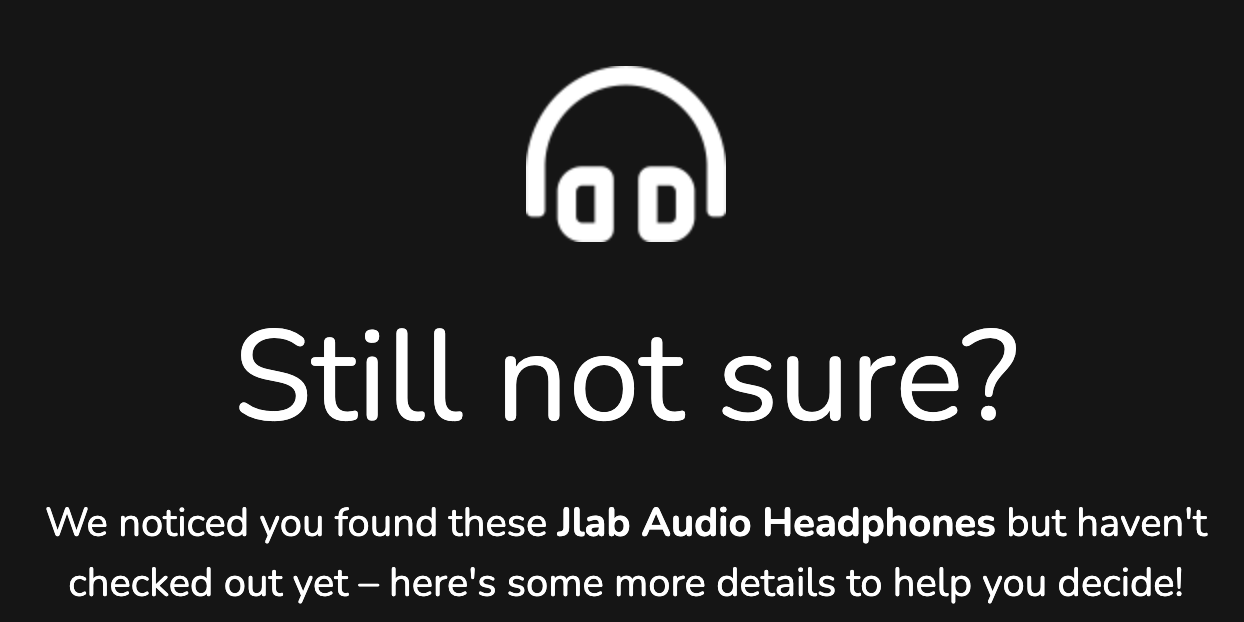
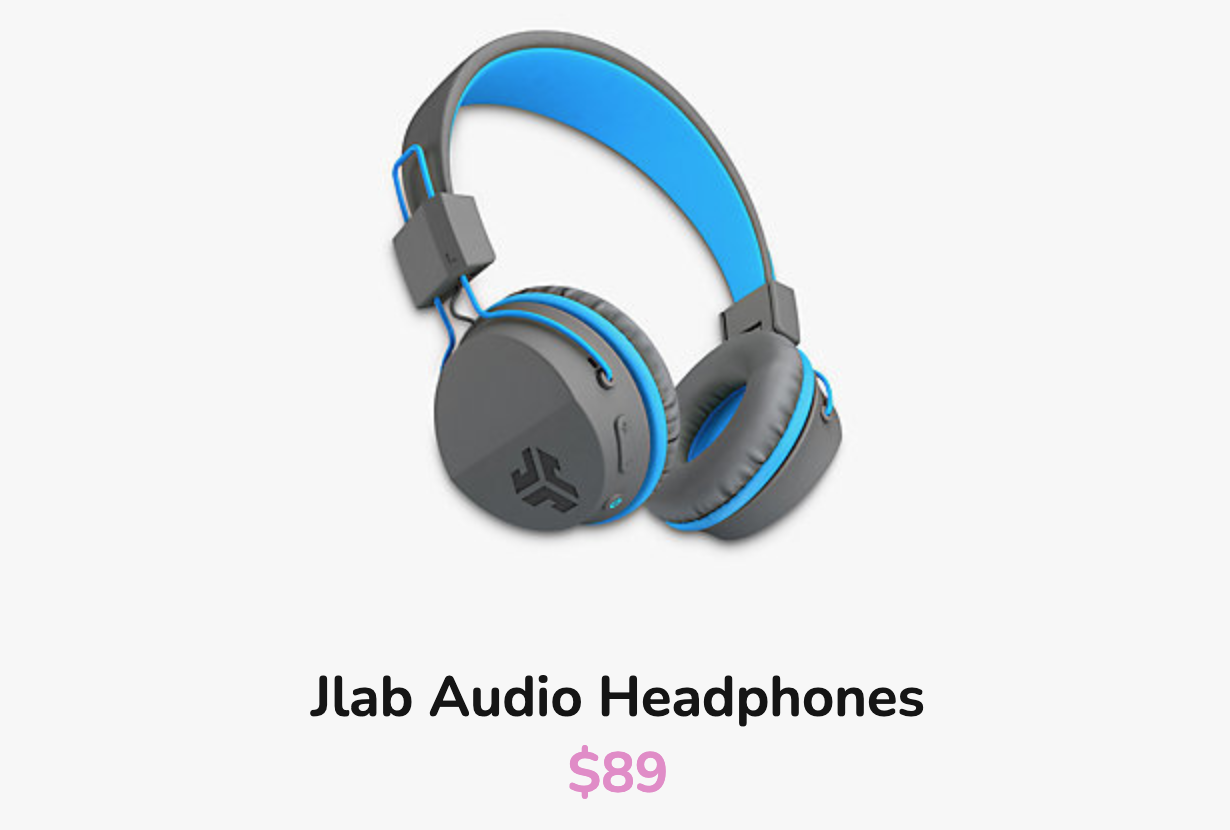
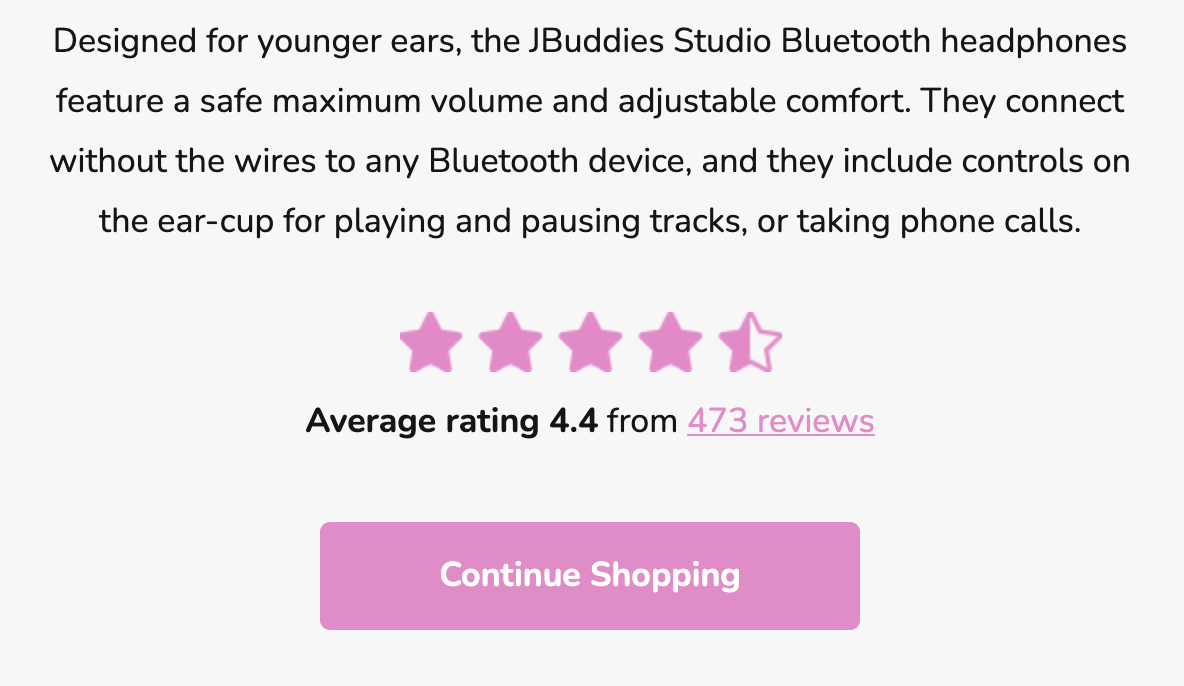
Nomad (email)
Subject line: Nomad Gear is Selling Out Quick
Selling accessories for electronics, Nomad really nails its brand with this abandoned cart email example: “Did your Wi-Fi crash? Fret not — we saved that shiny Nomad product you were just ogling.” The Internet and electronic accessories go hand in hand, and it’s also a lot more fun to read than, “You left something in your cart.”

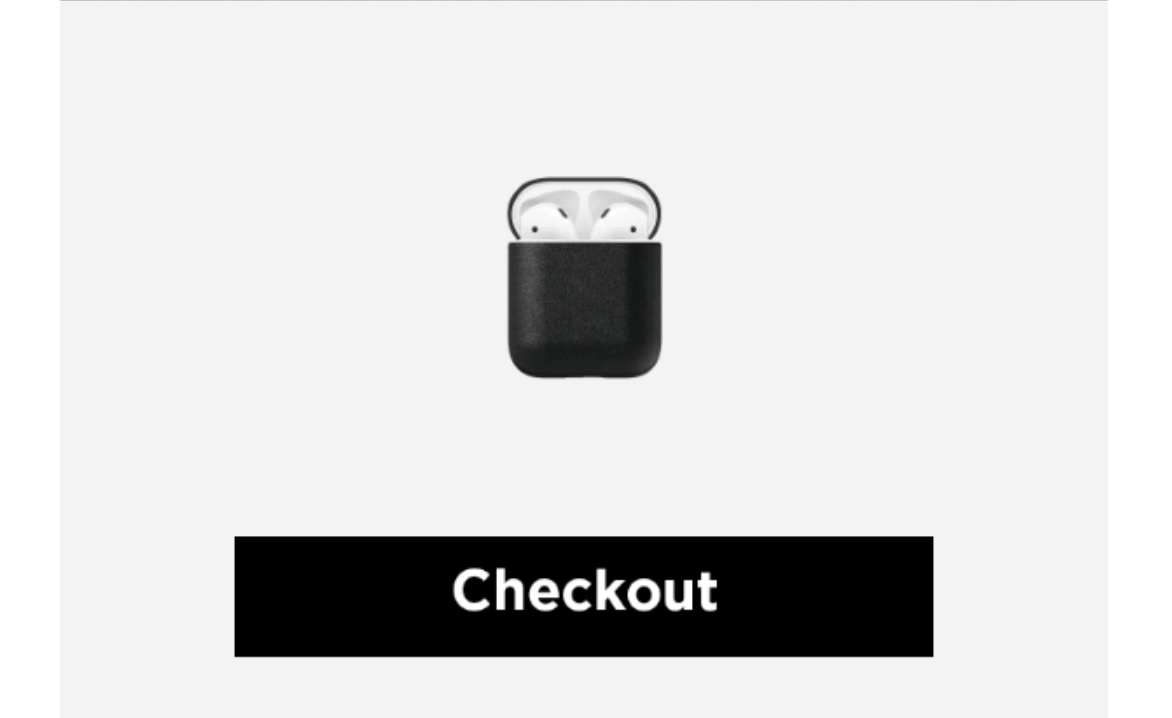

What we like about this email example:
- The color scheme works with the brand and product.
- There are two CTAs, so one will be in view no matter how far they’ve scrolled down in the email message.
- The opening text says they were viewing this product, but it doesn’t specifically say the item was left in their cart. They get the point across without spelling it out, and we like that.
What they could have done better:
- In the opening text, they reference “that shiny Nomad product.” We think this would be more impactful if they included the actual product name — or at least the product category.
- While we like the email having two CTAs, we aren’t in love with the text, “Seal the Deal.” Something stronger might have a better click-through rate, like if they swapped the CTAs, putting “Checkout” at the top and “Seal the Deal” at the bottom. But again, these are our opinions.
You left something (template)
The last of the Robly abandoned cart templates goes straight for a personalized approach with the header having their name front and center: “[FNAME], you left something behind!”
The design then gives you a spot to put the product photo, name, quantity, and price. While it’s not the main focus of the email, there’s also a place to give them a discount code at the bottom.
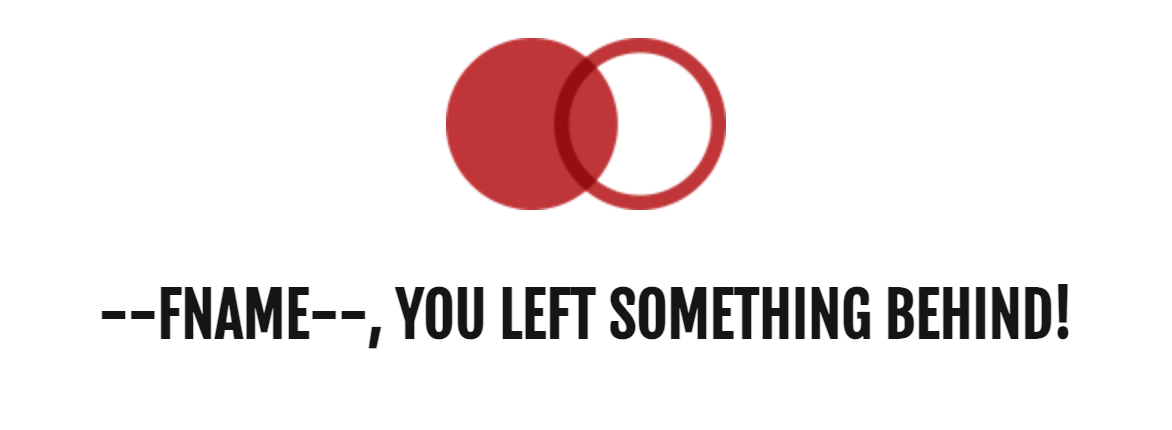


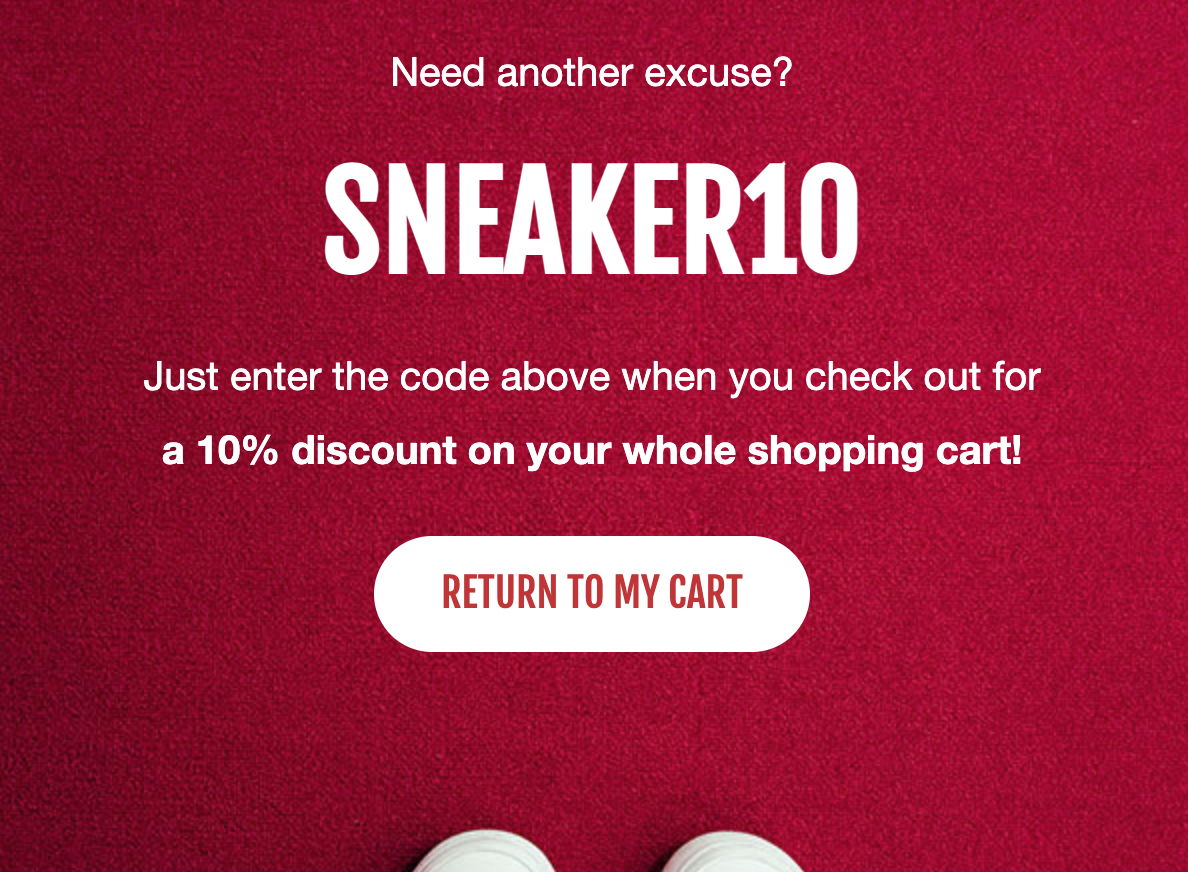
Public Rec
Subject line: You forgot something
Seeing this abandoned cart email from Public Rec makes us happy that a brand is addressing some of the consumer's top concerns right away. Right after their header text, “Take another look,” they go straight into, “Enjoy free shipping and free returns on all orders.” If a shopper failed to purchase the items in their cart because they were concerned about either of those things, now they know those won’t be an issue and can complete their purchase.
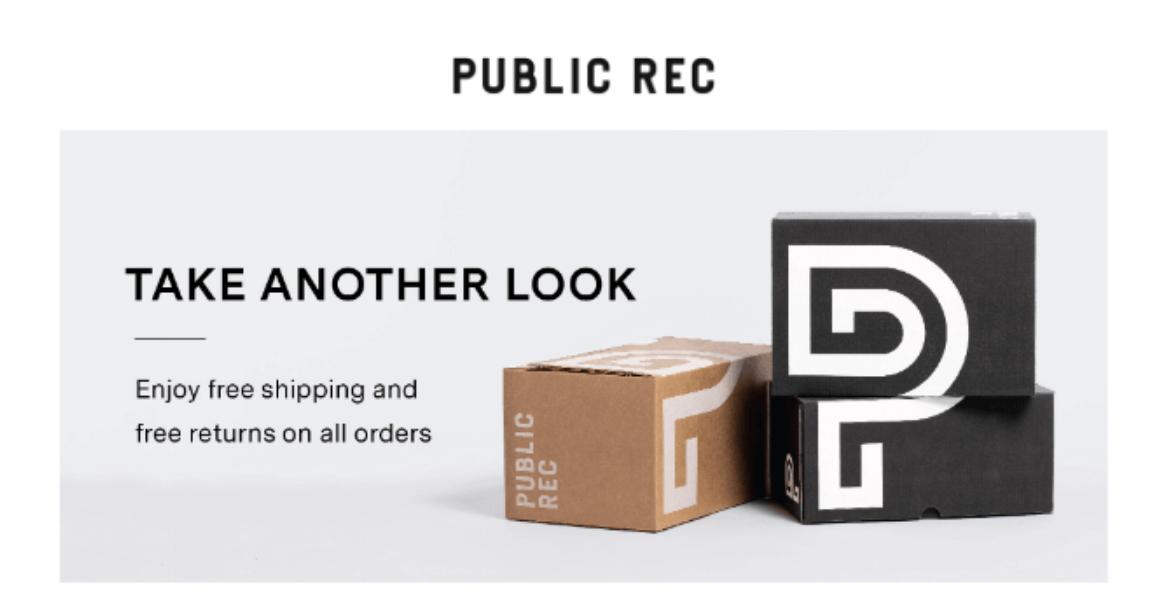
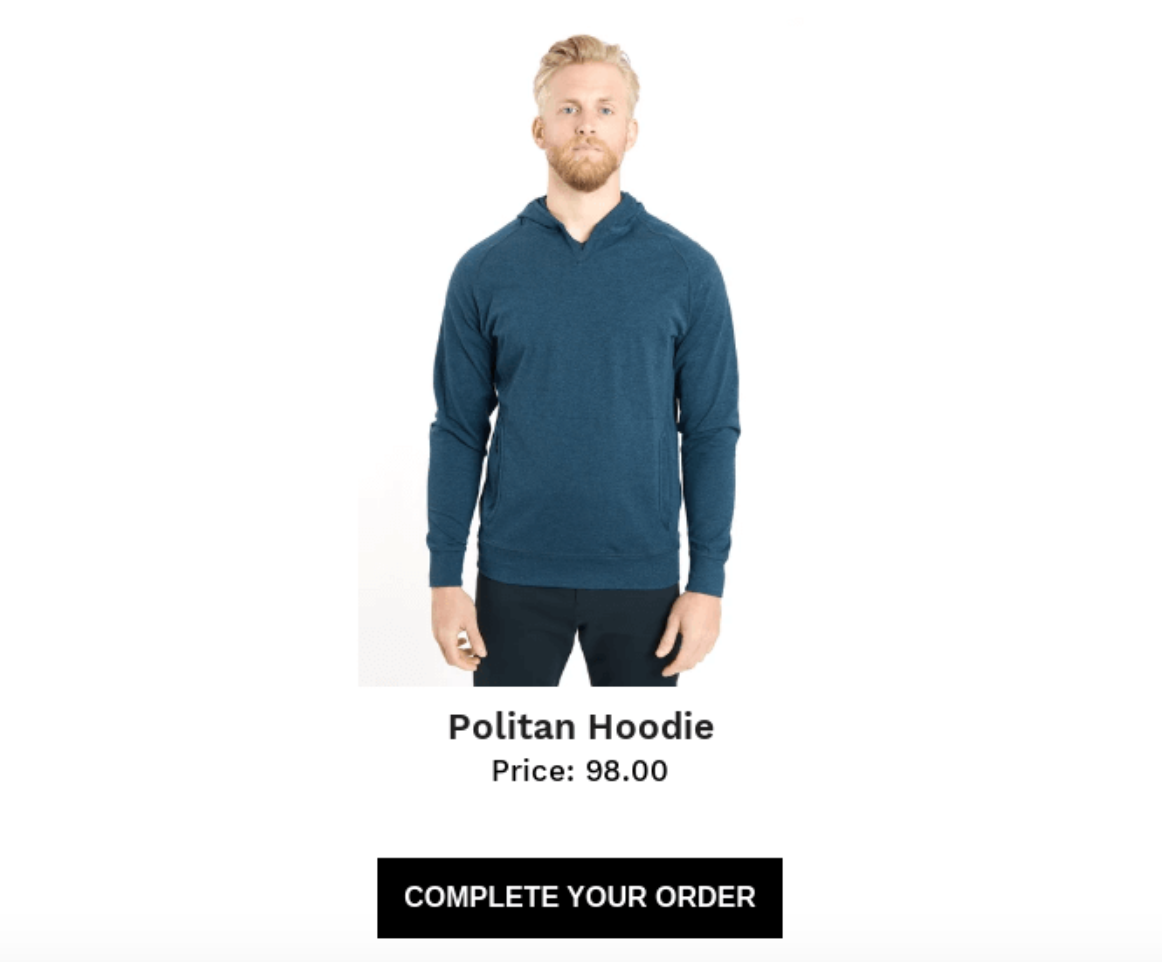
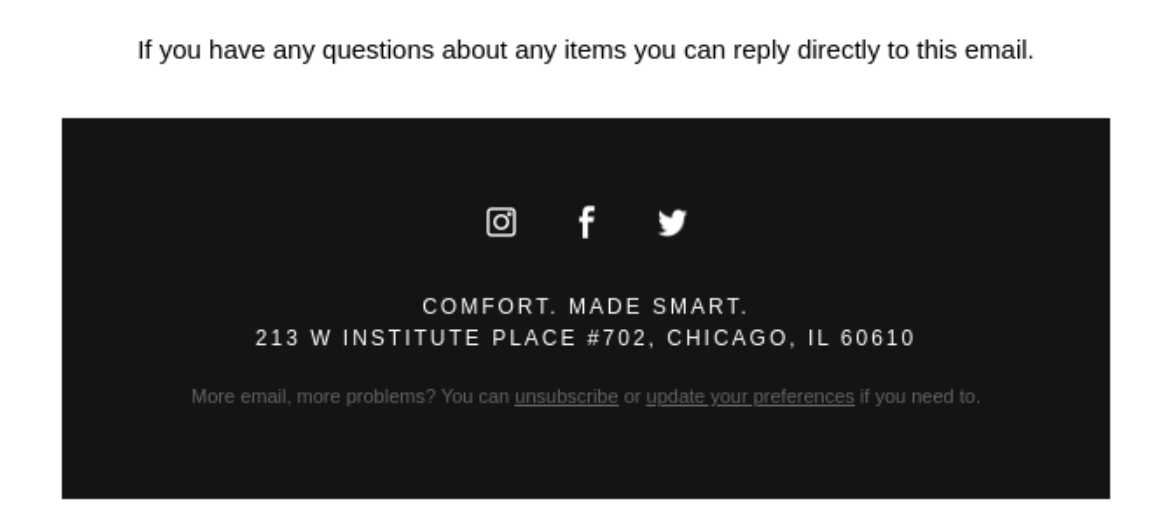
Here are more things we like about this email:
- They include the product photo, description, and price.
- There’s a clear CTA: “Complete your order”
- Shoppers can reply directly to the email if they have questions, which isn’t always the case with email marketing campaigns. The less work they have to do to get in touch with your brand, the better.
What they could have done better:
- We like this email if it’s the first in the abandoned cart series, but if it’s a later email, they could have added recommended/related products to show more options.
Mailchimp (template)
Mailchimp also has abandoned cart email templates, which include a default logo placeholder and Cart content block. That block inserts the abandoned item(s) into the follow-up emails. You can also use one of their other email templates. Just be sure to drag a Cart content block into the email layout.
They offer three pre-designed abandoned cart templates:

Here’s an up-close look at one of them:
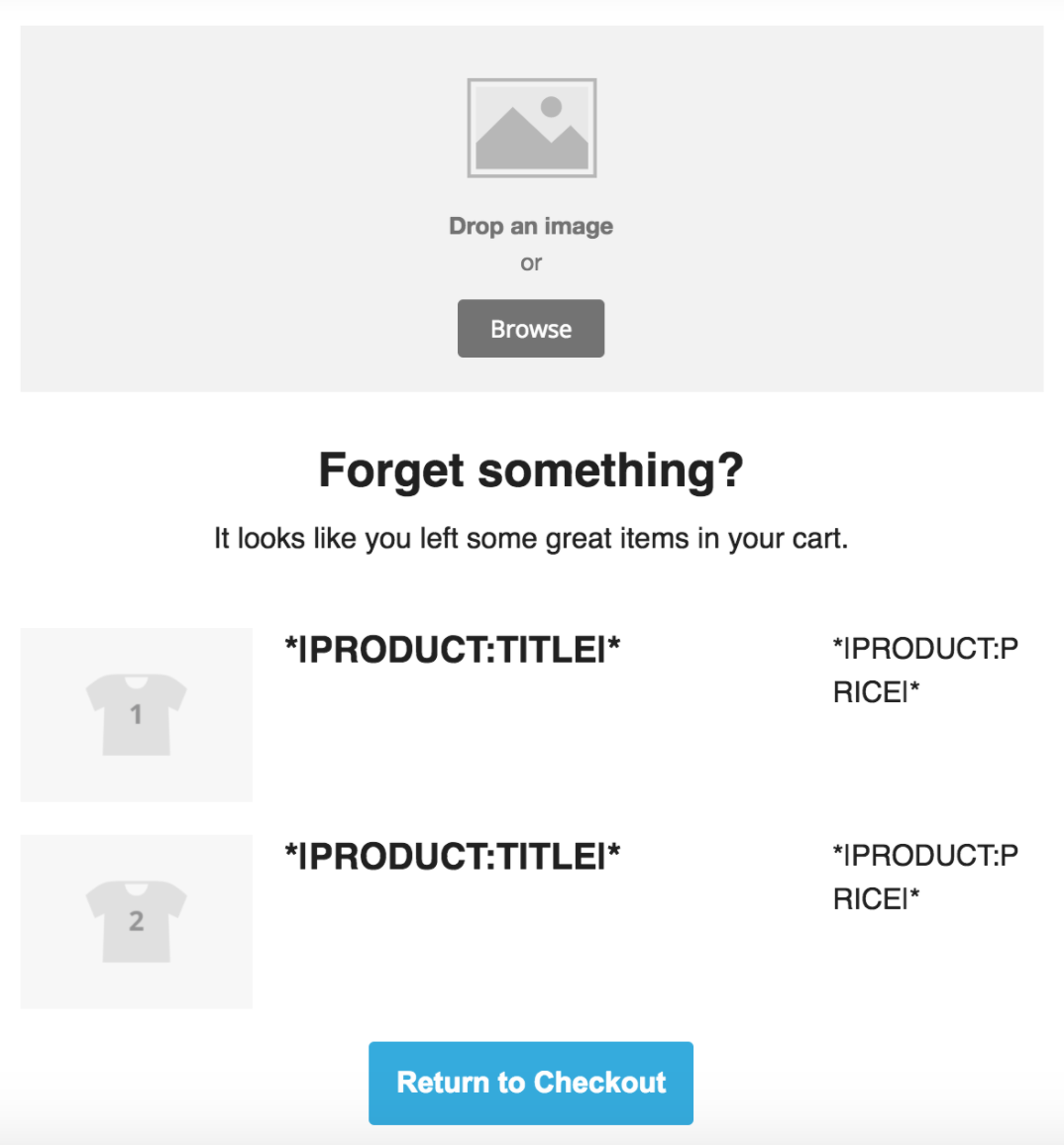
You can also customize the email information:
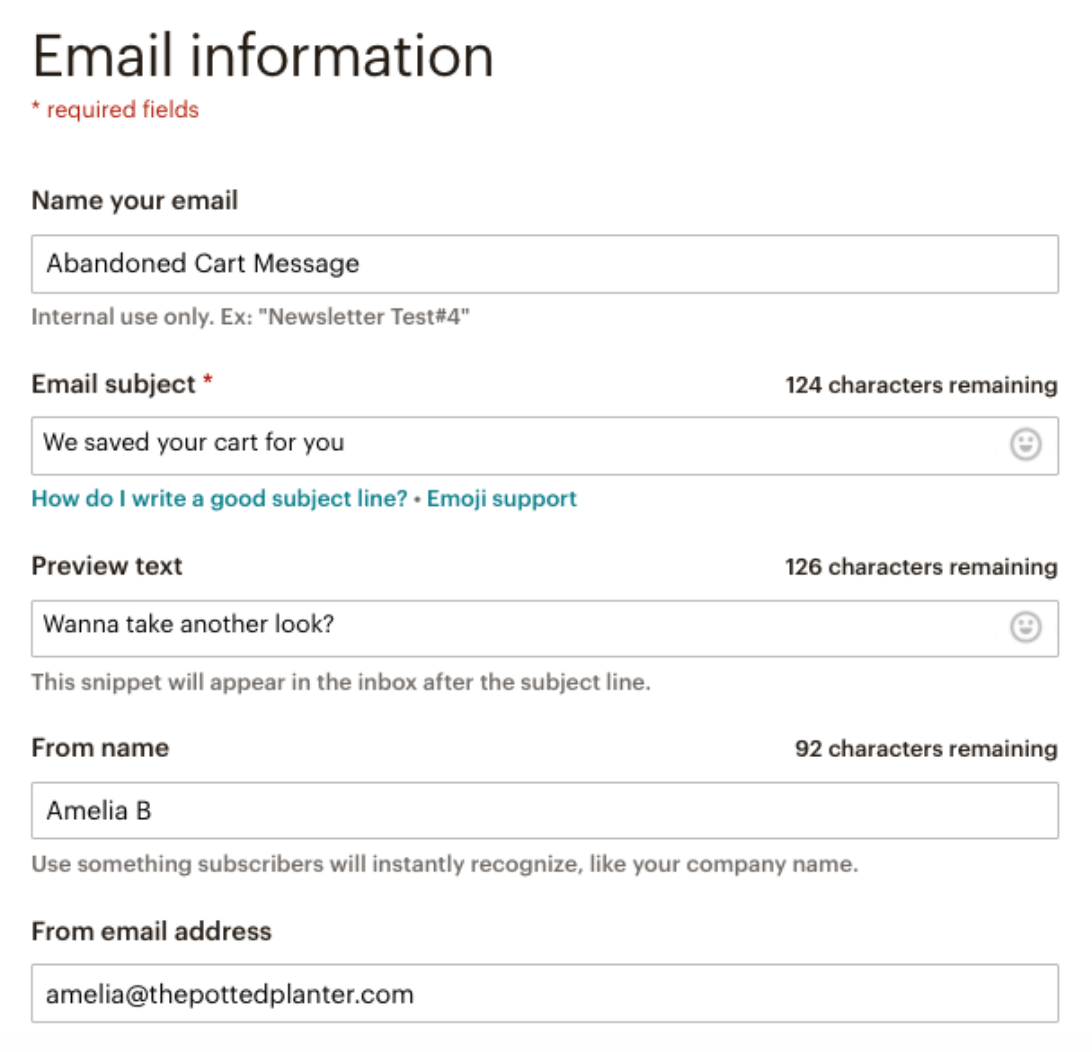
Jack Wills (email)
Subject line: Your basket is having abandonment issues… 🙁
We were hooked on this email from Jack Wills as soon as we saw the subject line. You don’t want to be the reason your shopping cart has emotional issues as they grow up, right?
They carry over that tone into the email with text like, “Don’t worry, we’ve got you,” and “We know life can be hectic.” So, they prove the subject line isn’t just a gimmick to get the shopper into the email: They stay true to that approach throughout the messaging.

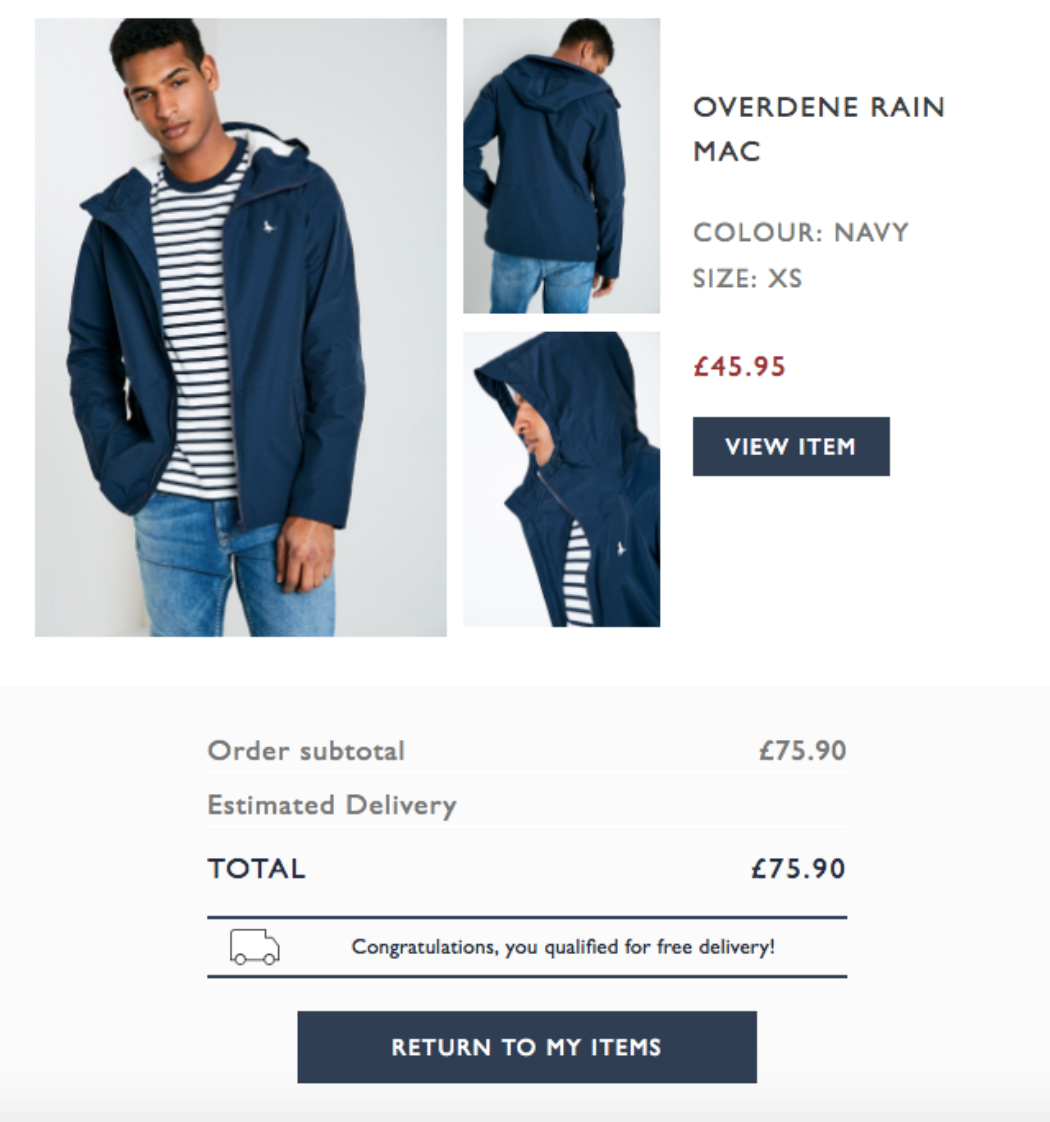
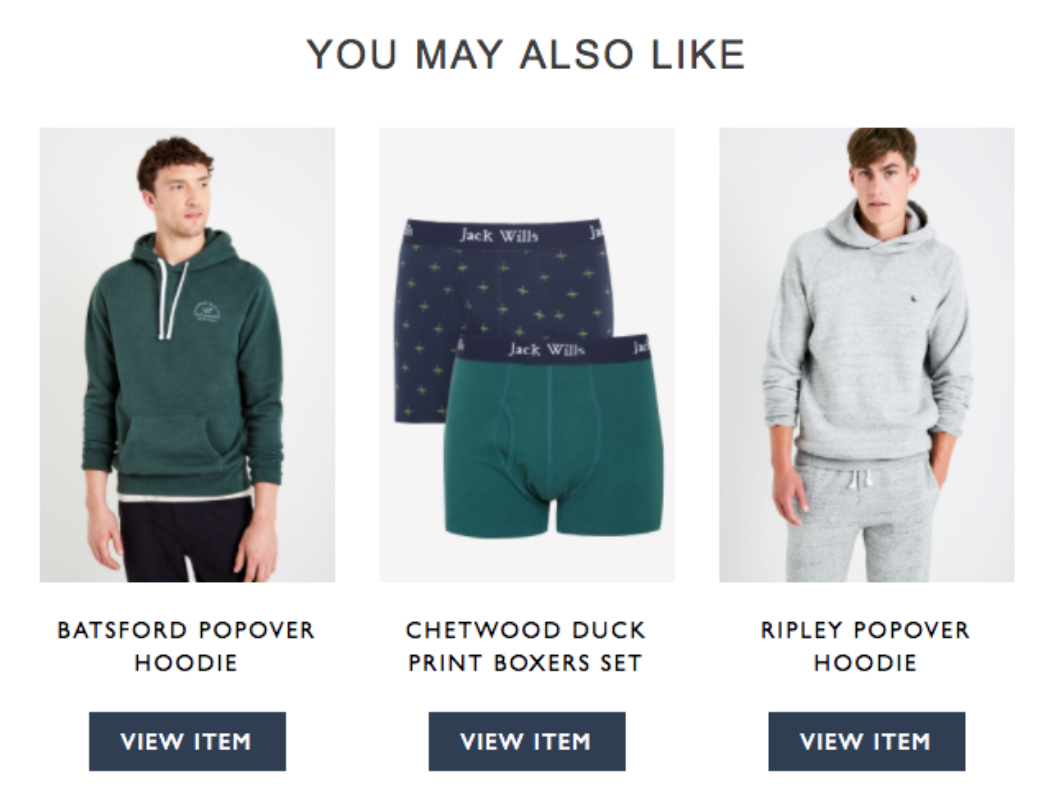
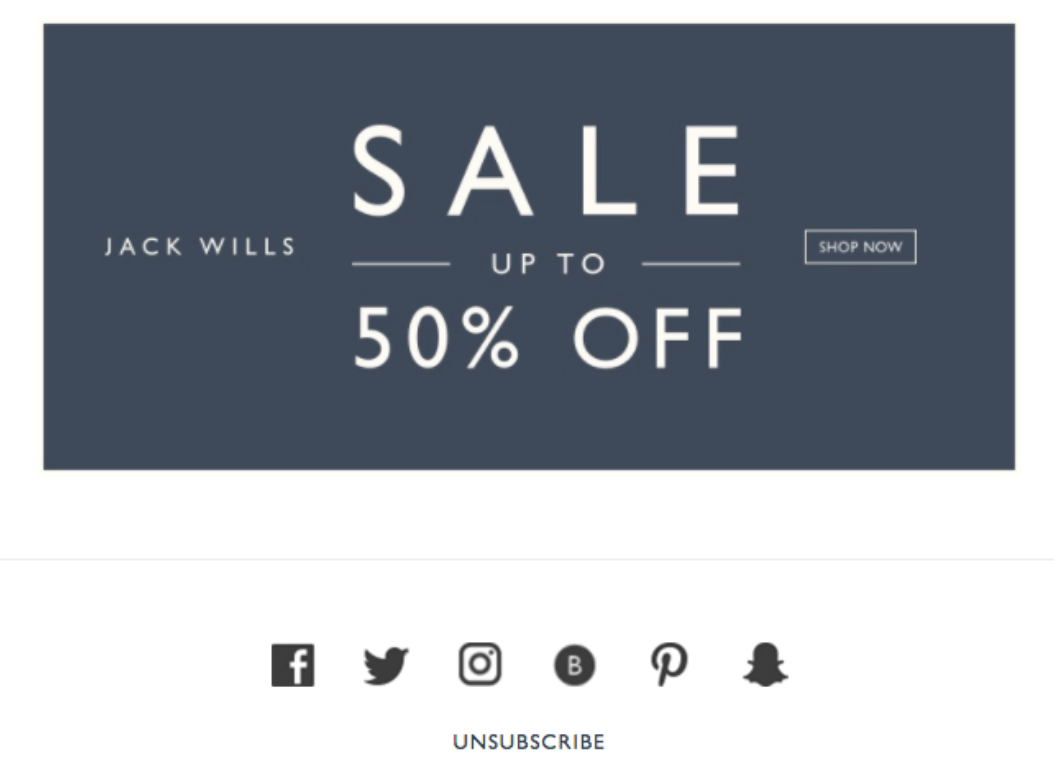
What else we like about this email:
- Though there are four main CTAs in the email body, there are only two different wordings: “Return to my items” and “View item.” So, it doesn’t seem overwhelming.
- They show different views of the product, which isn’t something you see very often in an abandoned cart email.
- In addition to the photos, there’s also the product name, color, size, and price. That pretty much covers it!
- And they take that a step further and include the order subtotal, which is a great addition when there are multiple items in their cart. They even show the estimated delivery cost, or in this case, free delivery (a major plus).
What they could have done better:
- There’s a lot going on in this email, from the products left in the cart to other related products and finally a sale that’s going on. That could become a bit much for the casual shopper, which is why it’s important to use A/B testing with your emails to see which approach works best for your specific audiences.
- While we love the approach they used with the subject line, if they wanted to make it even clearer, they could have used “cart” instead of “basket.”
Are abandoned cart emails compliant?
Abandoned cart emails allow you to provide a targeted, personalized campaign to already engaged online shoppers. Anytime you can do all of those things, you have a winning recipe for ROI.
One question many people ask, though, is if these emails are too good to be true. In other words, are they compliant? To answer that question, we’ll ask you one:
- Did you know you can send emails to people in the United States, even if they haven’t opted-in to your list?
The CAN-SPAM Act for the United States doesn’t require that a subscriber opt-in to your list, just that they can opt-out to any email you send. That’s why Retention.com can collect anonymous traffic off of your website and send you their contact information so that you can target them with emails. Just remember: This approach only works in the United States and isn’t GDPR compliant, which does require you to have explicit consent to email EU consumers.
To take that a step further, Retention.com is also Spamhaus compliant because, in part, we provide verifiable consent (the source record and opt-in date) of every email we pass along to our users. Those source websites’ privacy policies state that by opting in, the subscriber is agreeing that their information will be shared with a partner network for marketing purposes.
Start creating your abandoned cart templates
Now that you have a firm grasp on what does and doesn’t work with abandoned cart emails, it’s time to start creating some of your own and adding them to your automation series. Add your brand’s personal touch to the templates so your subscribers know exactly who it’s from, and test different versions until you find the winning combination. And if you want to start collecting engaged, anonymous traffic you don’t already have off of your site, we can help!
Not all emails are created equal. That’s why different companies have such a range of open and click-through rates. Abandoned cart emails are no different. To ensure yours is going to bring you the best results and get that contact back to their cart, incorporate these best practices into your abandoned cart email strategy. Which of course should be part of your overall retention marketing strategy.
With that, let's get started!

Subject lines
This is the first thing users will see when you send them an abandoned cart email, so don't disappoint. Nearly half of all email recipients say they open an email based on the subject line. So, what should you say to get the open?
The best approach is to keep your subject line simple and to the point. Let them know exactly why they are receiving this message. Consumers receive hundreds of emails a day, so cut to the chase.
Not sure what to include in your subject line? Try some of these components:
- Company name: Let them know who is contacting them.
- Customer name: Email personalization may help you get more opens.
- Friendly tone: If you can’t imagine saying it to a friend in normal conversation, rephrase your subject line.
- Product details: What exactly did they leave in their cart? Remind them.
- Urgency: If they might lose the items in their cart, let them know.
- Simplicity: Because the decision to open your email is made within seconds
Here are more than 10 examples of subject lines that work:
- Cart reserved: Open to see
- Don’t miss out! Your cart is expiring soon
- Empty your cart with 25% off
- Take 10 percent off before your cart is gone
- Still deciding? Your [PRODUCT] is waiting!
- Did you forget about me?
- [CUSTOMER NAME], did you forget something?
- Oops, you forgot something
- Where’d you go?!
- A gentle reminder…
- Your cart is expiring. You may qualify for free shipping
- There’s something in your cart
- Thinking about [PRODUCT]?
- Did you forget about me, [NAME]?

- Your cart MADE us send this reminder

- Is your wi-fi ok?
Adding personalized information, like the shopper’s name or the item they left in their cart, will better catch their attention and clearly state this email is just for them.
Create a sense of urgency
Alerting potential customers they might lose the items they’ve placed in their carts is a great way to tap into the scarcity effect as a marketing tactic, as long as you’re being honest.
You can do that by incorporating one of these tactics into your email:
- Reserve their cart for a limited amount of time (with a countdown)
- If their item is limited edition, let the know it won’t be restocked
- Set an alert showing how many other people have the item in their cart (similar to how travel sites tell you how many people have viewed that property in the past 24 hours)
- Let people know if their item is likely to sell out due to popularity
This email from Google is a great example of creating urgency:

From the headline, “Going, going, (almost) gone,” to the content saying their popular items sell out fast, this cart abandonment email is all about creating a sense of urgency. The email is short and to the point, which is a definite must for this type of message.
They also include the company’s contact information, which consumers could use if they had any questions or issues. That’s great to include in case the original reason they didn’t make the purchase was because of an issue or question.
Content
If your subject line does the trick, your potential customer will have made their way into the email body. Yay! Now that they are there, you’ll want to make sure your content makes these three points:
- They liked something enough to put it in their basket
- It was left in their online shopping cart
- They should return and complete their purchase
Everything you should include in your email is a means to that end. Basic elements to include in the email that will help you reach that goal include:
- Shopper’s name (if you know it)
- Sentence reminding them they haven’t completed their purchase yet
- Details about what they left in their cart
Your brand’s personality needs to shine through with every piece of marketing content, including your cart abandonment emails. That allows you to recover sales by being distinctive in a cluttered inbox.
This is a great example from Columbia:

Showcase product
The reason for your abandoned cart email is to get that shopper back to their cart to complete the purchase. One major part of doing that is showing them exactly what they’ve left behind.
- Don’t hide that information: Reveal that product like it’s on the Price is Right.

Using a large product image can turn a good abandoned cart email into a great one. Your abandoned cart email should be designed to reignite your customer’s excitement. There’s a reason the shopper added the item to the cart in the first place, so remind them of that.
People might not remember what products had them clicking the “add to cart” button in the first place. If they open your email and are still confused, they’re probably going to delete the email, and you’ve lost a potential sale. So, make the product image the main event.
Similar offerings
Maybe they didn’t complete the purchase because the product wasn’t the best one for them. To combat that issue, you can (sometimes) include an alternative product to the one in their cart. We say “sometimes” here because you might not want to do that with every abandonment email, since that could take away from the main one they really do want. They did add it to their cart, after all.
You could send them an email with the product in their cart as the main image. Then, include two or three similar product photos (with links) below that, in case one of those better catches their eye.
This approach is similar to what you see on Amazon’s “Customers who viewed this item also viewed” section:

Or, you can try showing them related items to include in their cart that won’t distract from the primary product, such as:
- Accessories for the main item
- Different patterns or colors for the same item
You want to give them items of value, without taking away from the item they obviously like.
Address issues

There are several reasons why people might leave their cart, as we covered above. So, why not address a few of those possible problems or questions in your email? That will help you cover several bases and get them back to their cart.
Using your customer research and website usability testing (or some of the top reasons we mentioned above), create an email that shows you understand their concerns and will address those issues directly with this abandoned cart email. That’s exactly what Whisky Loot did in this fun email:
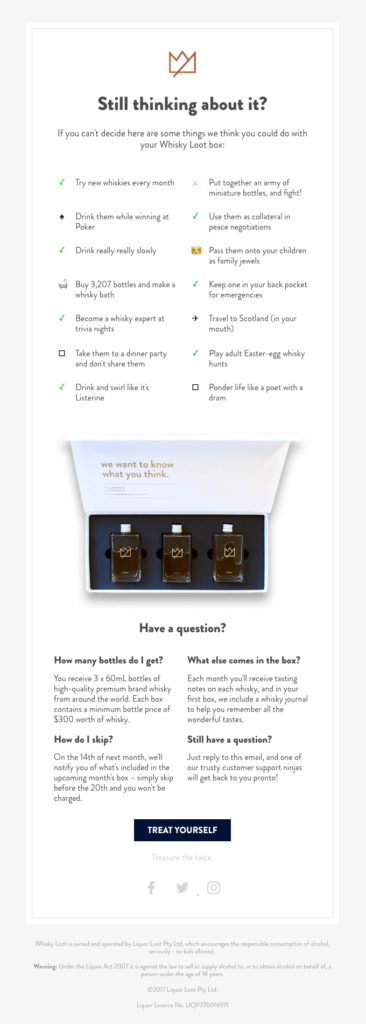
The brand stays true to its voice by sharing a lighthearted checklist of things customers can do with their product. The email also answers questions that might be holding up people from making the purchase.
This is a great tactic you can easily incorporate into your message. You can use some of the top questions you hear from people on your:
- Site
- Social media pages
- Surveys/research
Besides some of the top concerns — like shipping costs or returns — it can also help to include if you offer financing information for more expensive items. For example, if you provide 0% interest, include that in your abandoned cart email.
Big-ticket items require a significant commitment from an online shopper. These purchases are a big decision. It's your job to convince customers to trust in your brand, and the safety of financing without interest gives customers one less reason to bail out of the purchase. A large, “0% interest” banner is perfect for your price-conscious customers.
(Bonus: For expensive items, incentives like an offer or free gift are great ways of enticing the customer to complete their purchase — especially if that gift is an accessory matching the abandoned item.)
Also, make sure to give them contact information for your company if they have other questions, in case you didn’t cover theirs.
Call to action
Let them know exactly what you want them to do once they open your email (i.e. purchase the items in their cart). Do that by making the CTA prominent in your design. The components of a good CTA for an abandonment email are:
- Be direct (but nice). Your button could say “Return to your cart,” instead of using words like “buy” or “pay”
- Only include one CTA to make sure it’s clear what you want them to do (though there are a few exceptions to that rule, which we will cover later)
- Color/design of the CTA stands out from the rest of the email body
Here’s an example from Bearsville Soap Company that uses the “Return to your cart” CTA:

The CTA emphasizes how easily they can finish the checkout process they started, without being pushy. We also like the bear emoji in the subject line, which helps the message stand out and reinforce branding.
Frequency
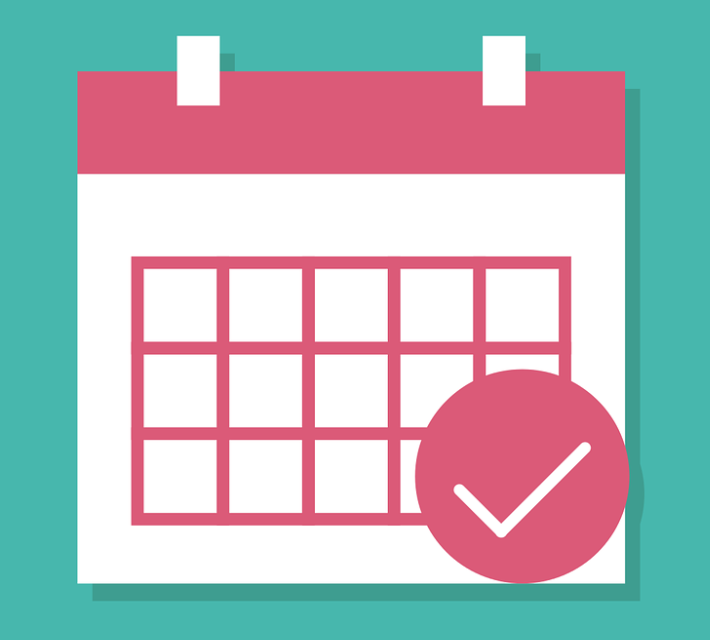
You can set up a series that goes out all on its own – and wins back revenue that would otherwise have disappeared. Like we mentioned above, you’ll want to send the first email fairly soon after they leave their cart. You should also continue to follow up with them using a series of emails if they don’t complete their purchase after the initial email.
This example sequence is one that many brands, including Target, use following a cart abandonment. It starts on Day 3:
-
- 3: Send first email with a subject line like “Come back and see what’s new,” with some sort of personalization at the front — “Kids’ Clothing: Come back & see what’s new”
- 4: Send a significant discount across the entire category the user was browsing. The offer should be front and center, placed directly in the subject line and as the first call out in the body of the email — “Need kid’s clothing? Take up to 25% off today”
- 4: A few hours after the first email is sent that day, send out another like “The price dropped for something in your cart”
- 5: Resend the notification regarding the price drop with an updated subject line — “Price drop alert”
- 6: If the previous attempts have failed, you can switch back to more category-specific offers. So, if they had originally added children’s clothing to their cart, you could try something like, “All of the outfits they’ll need for school.”
- 7: Pick out personalized products based on what’s in their cart. For example, if they added a boy’s sweater with a dinosaur on it, send them other clothing options that have dinosaurs on them with a subject line like, “Outfits he’ll roar about!”
As you can see, an abandoned cart email strategy includes way more than just one message. You want to use the information you have on them, like what they’re interested in, to provide the most targeted emails possible.
Here’s an example of an email series Wayfair sent after we added curtains to our cart:

They sent a total of five abandoned cart emails spanning nearly two months. These are the subject lines they used:
- CURTAINS you’ll love!!
- The curtain for you!
- CURTAINS & DRAPES: Living Room **SALE**
- ▓▓▓▓ CURTAINS & DRAPES ▓▓▓▓
- CURTAINS you’ll love!! [This one was sent at the beginning and end of their email series]
This is the email they ended the campaign with, which was similar to the first one we got:
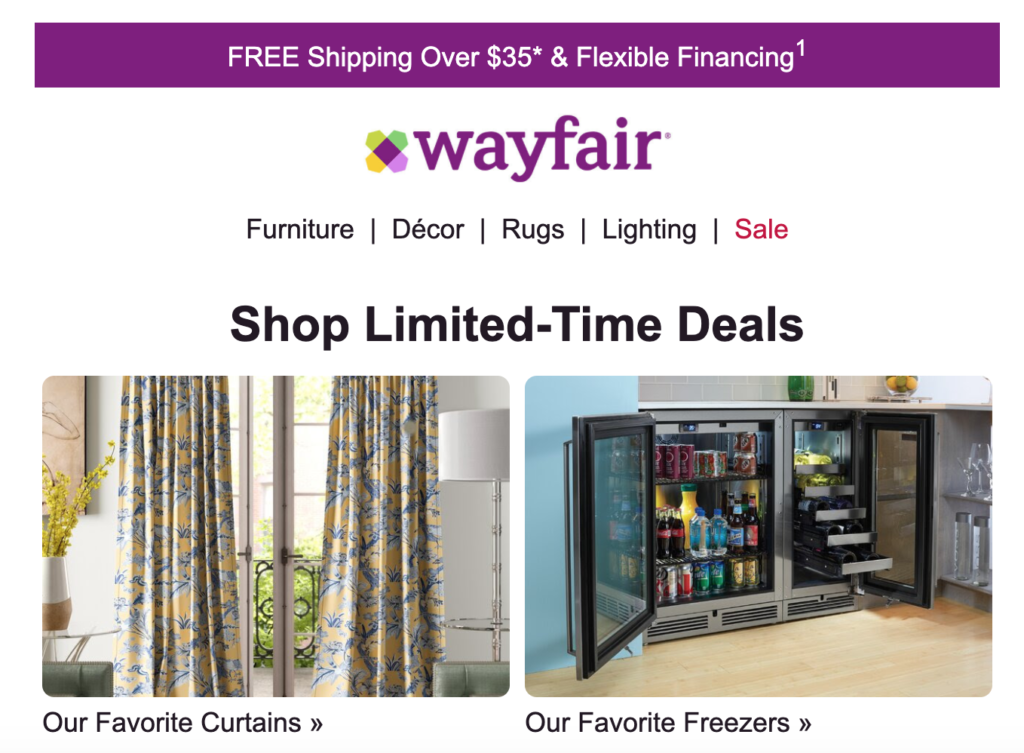
They not only showcased the product we had originally added to our cart (curtains), but they also included other popular home items.
Show proof

What do you do before making a purchase? We’d venture to say the vast majority of you look at reviews to see what others have to say about a product first. We all want to see that social proof, so use that to your brand’s advantage by including reviews in your abandoned cart emails.
Go through your reviews, and pull out the best ones for the product or service they’ve looked at. If you don’t have any, reach out to your top customers for one. The subject line could be:
- See what others are saying about [PRODUCT]
- Why this [PRODUCT] earned a 5-star review
- Our most talked about products
Unsubscribe
Like with any of your email marketing campaigns, you’ll need to include an Unsubscribe button or link somewhere in the body of your email. Make unsubscribing as easy as possible, so don’t try to hide it or make it super small.
It doesn’t help you or the shopper if they aren’t interested in receiving your emails, and they can always resubscribe later if they choose. If you try to force people into receiving your emails and buying your stuff, you’re destined for complaints, failures, and a struggle to maintain profitability. Let people opt-out before they start to distrust or dislike your brand.
An effective unsubscribe button usually is at the bottom of an email. That’s where readers will look. Try to use a different color, font, or even use italics to make an unsubscribe CTA stand out. You don't need to go overboard with font size. You can keep a smaller size font if you want, but make sure it’s readable.
In summary

Abandoned cart emails are about more than getting the shopper to complete their purchase. The email should also be helpful and answer questions so they can complete the purchase when they're ready.
Take this opportunity to create a lasting relationship with your customers and aim to convert your shopper into a loyal brand fan. You want them to become promoters of your business, not just a one-time customer.
While short-term profits from discounting and sales promotion are great, what happens when your promos run out and it’s just a regular day? If you have an effective email cart abandonment strategy in place, you won't have to worry about not having a sale to lure them in.
- You'll know your customers agree with the price you sell your products for.
- They'll be willing to purchase for the full price.
You’ve seen the stats, best practices, and tons of examples. You have power and knowledge. We’ve given you everything you need to make your abandoned cart emails the best they can be.
Remember...
Even if you follow these steps to a T, you might not be able to capture every single abandoned cart user. Not every shopper is serious about making a purchase, or maybe they are just comparing products.
Even if you don’t close every sale, you’re creating a solid foundation that will help the visitor learn about your brand, that you care about current/prospective customers, and make it easier for them to find your products if and when they decide to make a purchase.
It takes several interactions with a consumer before they ever convert, and abandoned cart emails are a great way to start engaging with them. So, it’s time to get started, and add them to your marketing strategy!
